How to Write a Restaurant Concept: Complete Easy-to-follow Guide + Examples

- 1. What Is a Restaurant Concept?
- 2. Benefits of Restaurant Concept Development
- 3. How to Write a Restaurant Concept

1. Find inspiration
2. pick a type of service, 3. research your target market, 4. choose your restaurant’s name, 5. create a menu that illustrates the concept, 6. illustrate the concept with restaurant décor, 7. write a convincing concept and promote it.
- 4. Restaurant Concept Ideas
- 5. Final Words
Are you planning on opening a restaurant? All the new terms, budgeting, and responsibilities may seem daunting at first, but you can succeed if you break everything into small, accomplishable steps.
Let’s start with how to write a restaurant concept, which you must do before you even start thinking about how to spend your money on location, equipment, and everything else.
In this article, you will learn what a restaurant concept is, how to write it, and find inspiration in the many examples.
What Is a Restaurant Concept?
A restaurant concept is the overall theme of your restaurant, starting from the type of cuisine and type of service and continuing with the menu design, décor, and ambiance.
The restaurant concept supported by restaurant branding will help you create a well-established business that is easily recognizable.
Read more : 12 Restaurant Branding Ideas to Build a Memorable Presence
Benefits of Restaurant Concept Development
The good news is that you don’t have to invest money in restaurant concept development. Sure, you could hire a marketing team, but it will be more personal and special if you do it yourself.
Here is what you will gain if you learn how to write a restaurant concept:
- Create a memorable experience : when picking a place to eat, people don’t just look at the food. There are so many options right now that potential customers seek out an experience. They want to be able to take photographs and rave about their dinner with their friends. By creating a unique restaurant concept, you give people what they want;
- Attract your target customers : your food will not be for everyone and that is ok. Developing your restaurant concept helps you identify your target market so you can better cater to their needs;
- Build a loyal base of customers : people who are a fan of your restaurant concept will keep coming back. Let’s say you have a casual old-style Italian restaurant. Clients who enjoy this type of food and atmosphere will become regulars;
- Enjoy long-term success : opening a restaurant with no attention to detail will increase your chances of failure. On the opposite industry, starting your adventure in the food industry with a well-thought-out restaurant concept increases your chances of succeeding year after year.
How to Write a Restaurant Concept
Let’s break it down into easy-to-follow steps, so you can learn how to write a restaurant concept in no time:
There are many other restaurants in your area, so you need to make yours stand out if you want clients to visit you. To come up with a great restaurant concept, you need to find inspiration, be it from your travels, your upbringing, or your culinary journey. Here are some things to consider:
- Did you grow up eating a certain type of cuisine that you would like to share with others?
- Have you visited a place that impressed you food-wise and would like to make it visible at your business?
- Have you experimented with food and you have a unique product to share with the world?
- Are there traditional types of food in your area that you want to keep alive or maybe put your spin on it?
- Do you appreciate a particular type of art that you think will translate well in a restaurant?
The type of service you offer will heavily impact how you develop your restaurant concept. Here are some options to choose from:
- Fast Casual
- Fine dining
- Ghost restaurant
- Family style
A restaurant can’t function without clients. Therefore, it makes sense you should know who they are, so you can develop a restaurant concept that will persuade them to visit your business.
After you settle on a general area for your location, do a bit of research and find what type of potential customers there are such as age, occupation, and interests.
For example, if you want to open a restaurant inspired by the paintings of Degas, find out if there is interest. Do people often visit the museums or are there any clubs dedicated to him?
Read more : Restaurant Target Market: How to Identify It and Why It Is Important for Your Business
If you want to open a fine dining restaurant focused on Neapolitan cuisine, it wouldn’t be fitting to call it “Pizza Gregorio”, even if you have your take on pizza on the menu. The name should signal the type of sophistication clients must expect.
Therefore, choose a name that embodies your restaurant concept. It would also help for it to be short and easy to pronounce so people will remember it.
This is probably the most important step of how to write a restaurant concept because it is the one that the client immediately notices. Your menu should illustrate the theme, from the types of dishes to the menu descriptions.
For example, if you want to open a burger joint, people won’t be interested in ordering the seafood pasta you’ve added to the menu.
Furthermore, the way you write your item names and descriptions should also be in line with the concept. For instance, if you have a fast-food restaurant with a fun theme, your menu descriptions should be playful.
If you want to create a menu in minutes with little effort, we recommend you use the menu builder embedded in the online ordering system from GloriaFood. It is very easy for customers and you can make unlimited changes to it, free of charge.

Read more : 3 Secret Menu Writing Tips: The BEST Food Descriptions that Make You Hungry
When you search for how to write a restaurant concept, you shouldn’t limit yourself to a written statement. Instead, your concept should be visible in almost all aspects of your business, from how you decorate your walls to what napkins you choose.
A visitor should be able to make out your concept from the moment they lie eyes on your restaurant.
A restaurant concept statement will vary according to the audience. We’ll give you a basic formula for how to write a restaurant concept and some tips on how to adapt it:
Why you chose to open the restaurant (Your inspiration) + What type of food do you serve + What makes your restaurant special
For your restaurant’s website’ About section, the above info will be good because you don’t want it to be overwhelming.
If you address a potential partner, consider adding more details, such as how the restaurant concept will be visible (décor, menu creation, name, target market).
While describing information, try to make use of powerful words & phrases and follow a compelling sentence flow for maximum customer engagement. If you face difficulty, then paraphrase the written concept through an online paraphraser .
Restaurant Concept Ideas
Before you start putting into practice all the advice above on how to write a restaurant concept, we’ve prepared a few ideas that could serve as inspiration.
- Malaysian Family Style restaurant : Our heritage has massively impacted the way we cook. We want to allow other people to explore the amazing Malaysian flavors packed in small servings that are meant to be shared. We welcome everyone to have a relaxed meal where they discover the food of our culture.
- Farm-to-table restaurant : We pride ourselves in the locally sourced organic ingredients that we get from our partners in the area. We aim to reduce as much waste as possible and use every part of our ingredients. Come in and enjoy a healthy meal and learn the story of the farmers who produce our ingredients.
- Protein-forward food truck : Do you need a quick pick-me-up after a workout? We prepare dishes packed with protein and we give you the calories and macro breakdown for every menu item. Reach your goals while eating delicious food that is served to you in minutes!
- Irish sports bar : Come watch your favorite sports team while enjoying a pint of stout with a side of our traditional Irish food. This is the best place to gather with your mates and forget about your worries.
- Fried chicken fast food : If you are craving finger-licking good fried chicken, this is the place to be. Our secret recipe makes the best crunchy, meaty, and savory chicken that you will dream about. We guarantee your meal will be served in less than 10 minutes!
- Reinterpreted traditional Greek food fine dining : Our Greek Chef has a lifetime of experience with traditional Greek food, from lessons from his grandma to extensive travels around the country. He has now put his spin on the amazing food and offers you a dining experience you will never forget.
- Spicy virtual restaurant : All spicy lovers, unite! All our dishes have the kick you crave, from our curries to our mouth-watering pad Thai. If that is not enough for you, check out our homemade spicy sauces in flavorful combos.
Final Words
Now that you know how to write a restaurant concept, it is time to search for your inspiration. Do your research so you can pick a unique concept and rely on useful tools like our menu creator, to make it obvious for your clients.
Otilia Dobos prides herself on well-documented, easy to understand and SEO-optimized content, both short and long form.
Get your own FREE restaurant ordering system!
Get instant access now, forgot password, password reset email sent.
- Shop CentralRestaurant.com
The 8 Steps to Designing a Restaurant Concept
by Kelsey Moriarty | Jul 20, 2019
Introduction
Understanding all the steps required to transform a vision into a finished restaurant concept can help you budget well and avoid pitfalls.
Designing a restaurant concept isn’t simply a matter of constructing an attractive dining space or an effective food production kitchen. It’s a fine balance of accomplishing your objectives within a manageable budget. Because restaurants are subject to so many regulations, the design must not only be efficient and aesthetically pleasing but also keep food and customer safety top of mind.
Like any other construction process, how much it costs to design a restaurant and build it can vary dramatically and depends on its purpose and function, as well as whether you’re building from scratch, building out a leased space or renovating an existing restaurant space.
Knowing what steps are involved in the process can help you set an adequate restaurant budget up front, and result in a project that requires minimal change orders during construction, stays on schedule and stays on budget.
The process starts when you assemble a team, which will likely include an architect, a foodservice consultant or designer and an interior designer.
8 Steps of the Design Process
- Predesign
- Schematic Design
- Design Development
- Construction Drawings
- Construction Documents
- Permits and Final Bids
- Construction Oversight and Management
- Walk-Through
Related Articles on How to Open a Restaurant:
- Your Complete Guide to Opening a Restaurant
- Deciding What Type of Restaurant to Open: Independent, Franchise, or Food Truck
- Planning for a Smooth Restaurant Opening
- Selecting Your Restaurant Equipment Dealer
- Having a Plan: The Importance of Planned Maintenance
- Staying on Budget When Opening a Restaurant
- 8 Surprises to Anticipate When Opening a Restaurant
- 7 Secrets to a Successful Foodservice Equipment Installation
Step 1 | Pre- d esign
Much of the homework you do to write your restaurant business plan comes into play during this phase of the design process, says Steve Starr, president, starrdesign, Charlotte, N.C. “In this phase, you and the team you choose need to clearly understand your objectives and your budget model,” he says. “Then your team will want to do a brand audit, to make sure you’ve clearly defined the brand and identified the target customer; an operational analysis; and market analysis to see how your competitors’ restaurants are laid out.
“Finally, we’ll normally do a site analysis for our clients to see what’s actually needed on site before lease negotiations begin. For example, is there enough parking? How will we handle HVAC? Is there space for hood ventilation or will we have to run ventilation shafts up nine stories to the roof? Is there room for refrigeration equipment? What about plumbing, electrical service, gas lines? Does the building meet fire and building codes”?

Step 2 | Schematic Design
At this stage, the design team works with you to define how the restaurant will operate, how it will look and what the customer experience is intended to be like. Architectural plans are drawn up for new builds, and floor plans and renderings will show you the restaurant design layout and appearance of the restaurant.
“I believe strongly in 3 – D modeling, even at this early stage,” Starr says. “It helps operators envision what we’re trying to do for them, and it makes it much easier to spot design flaws”.
Step 3 | Design Development
With the general concept down on paper and approved, the next step involves defining all elements of the design, from fittings to finishes. Your architect, engineers (construction and HVAC), consultant/kitchen designer and interior designer will work together to draw the elements they’re responsible for, document each and make sure that all the elements are consistent.
Step 4 | Construction Drawings
All of th e information determined in the predesign, schematic design and design-development process will be used to develop construction drawings. You and your team will use these to get bids from general contractors. It’s highly recommended that y ou get at least three bids. Different contractors can come up with surprisingly different prices from the same set of drawings. Two bids aren’t enough to give you confidence in the prices quoted; four or five bids are too many to manage and give contractors less motivation to take the time to bid accurately if they have only a 20 percent chance of winning the job.
TIP: Keep Drawings Up-to-Date Throughout the Process
One common problem in restaurant projects is people working off of conflicting drawings. There may be many sets of drawings—the architect’s plans, the foodservice designer’s plans and so on—and different members of the team, such as the equipment installer, will reference them at different times. Stay connected during the build to make sure that members of the team have the most accurate and current versions of the drawings they need.
Step 5 | Construction Documents
The next step is producing construction documents that specify exactly how to build the structure, where to run utilities and the schedule of when each phase sh ould be accomplished so the general contractors can secure and schedule subcontractors and adjust their estimates , if necessary .
“Coordination between the architect, engineers, foodservice consultant, and equipment installers is supercritical at this stage,” Starr says. “ We may have specified a stove with a gas connection placed in a spot that would be difficult to access from where the gas line hookup is placed in a construction drawing. It’s a lot less costly to correct these discrepancies on paper than it is to go back into a facility after everything’s been built and try to fix it”.
Step 6 | Permits a nd Final Bids
You ’ll need the construction documents to get permits from your municipal government’s building department and various regulatory agencies that will be involved. Allow time in your planning for these agencies to get you the approvals you need.
“Many places now offer an expedited permit process for businesses like restaurants,” Starr says. “They may cost extra, but it’s well worth it to use these resources. If they don’t have a program in place, expedite the permitting process in any way possible so you can keep your project on schedule”.
Make your expectations and construction timing known to the general contractors who are bidding on the project, so they can fine-tune their estimates and give you accurate budget information.
“Even at this stage the information you get from GCs m a y be based on general conditions,” says Starr. “ In this construction market. You may be better off getting rough bids from GCs based on your concept development , and select the GC who can get the best subcontractor pricing they can”.
Either way, the team will help you evaluate the bids and choose a general contractor .
Step 7 | Construction Oversight and Management
During construction, the design team —restaurant owner , architect, consultant, and contractor — should meet on site weekly to assess progress, discuss any problems that arise and confirm next steps. Communication is key, and all parties need to closely review project details and make sure they’re on the same page.
You should do a walk-through with the team at these meetings to go over punch lists and verify rough-ins for utilities, doors, walls, and ceilings. As progress is made, you should pay close attention to things like conducting an independent test of the HVAC and kitchen ventilation systems , verifying they’re balanced. A restaurant that didn’t check discovered on opening night when the kitchen hood ventilation fan was on high that customers couldn’t open the front door because of the air pressure.
Test and check all systems as they’re complete d . For example, have the manufacturer of the lighting controls come in and test them to make sure the electrician installed them correctly.
Have an equipment dealer like Central Restaurant Products verify that utility hook-ups are adequate and properly placed for the equipment you’ve specified before installation so any problems can be more easily addressed.
Once the equipment is installed, b ring equipment manufacturers in for startup, testing and calibration before you begin employee training to make sure everything works properly and nothing’s defective or installed incorrectly.
Step 8 | Walk-Through
When everything is done, walk through the restaurant with your design team and the punch list to verify that all work has been completed to your satisfaction. Now you’re almost ready to open. To make sure you’re opening goes off without a hitch, see “ Planning A Smooth Opening “.
Related Resources
- Planning a Smooth Opening
- Staying on Budget When Opening a Restaurant
Kelsey Moriarty is a Content Specialist at Central Restaurant Products. Her focus at Central is in the Food Prep and Furniture areas. Kelsey’s background is in technology and marketing with particular experience in SEO and E-Commerce. She enjoys helping customers make better decisions as well as working on her copywriting skills!
Submit a Comment Cancel reply
Your email address will not be published. Required fields are marked *
Recent Posts
- The 6 Best Commercial Freezers
- The 6 Best Commercial Refrigerators
- What is the Best Oil for Deep Frying?
- Mastering Pizza Perfection: Exploring Commercial Pizza Equipment
- The 2 Best Gas Commercial Pizza Ovens
Top Posts & Pages

- Who We Serve
- Existing Restaurants
- New Restaurants
- Independent Operators
- Private Equity Investors
- Multiple Unit Operators

- Investment Opportunities
- Restaurant Consulting
- Additional Services
- Operational Analysis
- Restaurant Management
- Quality Assurance
- New Concept Development
- Brand Concept
- Kitchen Design
- Startup Consulting
- Business Plans
- Feasibility Study

Get A Free Quote
We will never spam you.
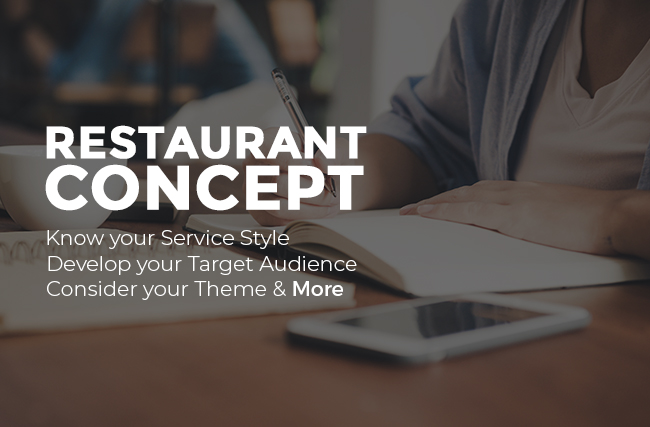
Recent Posts
- Restaurant Menu Development – What is It and How can It Increase Profits?
- TRG Consultancy: Your Key Ingredient for Restaurant Success
- Restaurant Remote Management: Budgeting for a Profitable Restaurant
- Restaurant Kitchen and Bar Design Efficiencies
- How To Open a Restaurant
- February 2024
- January 2024
- December 2023
- November 2023
- October 2023
- September 2023
- August 2023
- Brand Consultant
- Commercial Kitchen Design
- EB5 Visa Opportunities
- Fast Casual
- Food Cost Management
- Food Service Design
- Foodservice Equipment
- Foodservice Innovations
- Fruit and Vegetable Guide
- Hospitality consultant
- Menu Design
- Online Management
- Opening restaurant
- Operations Analysis
- Press Release
- Public Relations
- Restaurant Business
- Restaurant Business Manangement
- Restaurant Concept
- Restaurant Consultant
- Restaurant Delivery
- Restaurant Design
- Restaurant Marketing
- Restaurant Names
- Restaurant Operations Assessment
- Restaurant Profits
- Restaurant Rendering
- Restaurant Reopning
- Restaurant Tech
- Restaurant Trends
- Season’s Produce Guide
- seasonal cooking
- Seasonal Foods
- Sesonal cooking
- Spring Food
- Spring Fruit
- Spring Vegetables
- Summer Trends
- Uncategorized
A Step-by-step Guide to Creating a Restaurant Concept

Successful restaurants do more than just sell food. They sell an experience, and this is closely tied to the restaurant concept.
A restaurant concept is the overarching theme of the restaurant that covers its ambiance and decor, location, menu, service style, vibe, and culture.
It may not come to you clearly at first, as a myriad of ideas can flood your mind, but defining your restaurant concept is one of the most exciting parts of planning your restaurant business.
The Ingredients of a Restaurant Concept
Coming up with a restaurant concept is an interplay of creativity, strategy, personal experiences, the locale, and other factors that impact how you want your restaurant to be conceived.
Here’s a step-by-step walkthrough of the process of creating a restaurant concept.
Know Your Locale’s Character and Target Market’s Demographics
Your location will give you an idea of who will make up most of your diners. If you’re in a high-end, cosmopolitan district, you should be able to cater to the upscale, sophisticated crowd.
If you’re in a laid-back neighborhood, your restaurant should understand the local traditions, ingredients, and culture. You should be able to align your concept with their ways and sensitivities.
Find Inspiration For Your Restaurant Concept
What makes your heart smile as you think of having your restaurant? You can incorporate that into your theme. Draw inspiration from your childhood memories, heritage, local ingredients, traditions, family recipes, or anything that warms your heart
You may want to highlight a local iconic dish, a culinary tradition, an architectural design, or an era. Or, share a part of your experience as a chef, traveler, parent, or artist.
Define What Makes You Stand Out
There must be something that you can offer that others can’t. Whether it’s the menu, your interior design, service perks, or a unique recipe, it’s best to bri
This way, people will be curious about the new experience they will get from your restaurant. If it pleases them, they will give you a spot in their headspace as a go-to place for dining and enjoying.
Develop You Menu
Your menu should be aligned with your concept or vice versa if your concept’s starting point is the menu. The menu conceptualization may be generic at first – classic, modern, fusion, etc.
From there, you can add your own touch, like incorporating an ingredient that abounds in your hometown or a cooking method from your favorite country.
Choose a Service Style
Like the menu, this element directly impacts the dining experience, so you have to carefully choose one that will go well with your theme and serve your target customers best.
You can choose from quick service (fast food), fine dining, casual dining, buffet service, cafe, bistro, bar, gourmet, food truck, pop-up, or family style.
Design Your Restaurant to Suit Your Theme
The decor and ambiance of your restaurant will be the first thing diners will notice and experience as they walk through your door. Make a good impression by tying your decor to your theme.
Give your diners an immersive experience they can enjoy having again and again. From the signage to the washroom, floor to ceiling, and each piece of furniture and fixture, even the music and lighting should reinforce your theme.
A Winning Restaurant Concept
An excellent concept sets you off to a good start because it’s like having something tangible that people can recognize and feel an affinity to. Whether classic or edgy, your restaurant concept should work for your goals — attracting and keeping your target market.
A winning concept is one that your restaurant can have as a strategy and legacy – transcending trends and evolving while keeping its core identity intact.
Need assistance with your new restaurant concept? Let experts guide you. TRG Restaurant Consulting can give you a hand so you can ace this crucial part of your restaurant planning and execution.
Get a free quote today.
Share this:

TRG is an organization of hands-on operating professionals specializing in consulting services, restaurant operations, management, design and branding.
Services Available Nationwide: 877-777-6175
Interested in Working With TRG?
Send a message to set up a meeting with our team
How To Create Strong Restaurant Concept | A Guide

Have you ever visited a restaurant that made you feel like you were entering a whole new world? When you pick your date spot for the night, do you consider how the space will make you feel? The ambiance, the vibe, and of course, the food? These impressions are the impact of a restaurant concept. Even though it might seem like a lot of work to sit down and draw out a restaurant concept, it's the most fun part of opening your doors, and filling seats. Let your imagination run wild as we walk you through a guide to building a restaurant concept that turns heads and will keep people coming back for more.
What is a restaurant concept?
A restaurant concept is an overall theme or idea that will come to define your restaurant. Five factors that contribute to a restaurant concept include:
- Menu design
- Service style
- Ambiance and decor
- Style of food
- Vibe, culture and ethos
How do you choose a restaurant concept?
Often, a restaurant concept is born from the personal interests or experiences of the chefs or other contributors to the restaurant's opening. Some common contributing factors that help people choose a restaurant concept include:
- Local ingredients
- Travel experience
Because food is an essential blend of all of these facets, it's no surprise that these things help develop an emerging restaurant's theme.

How do I create a great restaurant concept?
A great restaurant concept can be established with a mix of passion, creativity, consistency, and strategy. You will want to keep the following 5 things in mind when building one out:
1 - Identify your inspiration.
Whether you are a top chef, a restaurateur, or a combination of both, it's time to get to thinking and dig deep to discover your inspiration for opening a restaurant. Whatever food you frequently gravitate to is an excellent place to start. Otherwise, consider looking into your upbringing or your heritage. It's not uncommon for your inspiration to be born from something random.
Recently I visited a restaurant in Kelowna; BC called " Skinny Dukes " that featured the most authentic '70s throwback you ever did see. The menu was a bit of a mish-mash (It was a missed opportunity to offer a cheese fondu, if you ask me) but delicious, and the overall experience was one for the books. 10/10 would dine again.

2 - Define what makes you unique.
There's no fun in doing something that others have already done before. Part of the thrill of being an entrepreneur and restaurant owner is having the freedom to be unique in your endeavors. Figure out what it is about the restaurant that will make you stand out from the rest and lean into that. What will make people excited to check out the new neighborhood spot? And even more important - what will keep them coming back?
3 - Research your customers and location.
Where are you located, and what type of customers will you likely get based on that location? Research the demographic near your site and other restaurants and competition in the area. Give the people what they want - for example, if you are in a pizza desert, be the pizza hero your community needs.
4 - Develop your menu.
Your menu needs to keep with your overall concept, so if you are working backward, consider the type of food you are interested in creating. If it's simple classic dishes, you'll likely have a traditional concept versus something scientific, modern, and edgy. Whatever you choose, run with it. Just make sure you stay in line with your theme.

5 - Select a service style.
Once you've figured out your menu, you can move on to determining your service style. The two should fall in line quite nicely. Think of dining experiences you've had in the past and when all else fails, check out the competition to see what they're doing.
Service styles to look into:
Although you might think that the style of service is irrelevant to the restaurant concept, you should think again. Service styles directly impact the guest experience, which correlates with your concept.
Here are 12 different service styles to consider implementing at your restaurant:
- Coffee shop
- Family style
- Fast casual
- Fine dining
- Ghost restaurant
- Mid-scale dining
6 - Choose a restaurant concept that fits your personality.
First and foremost, you should develop a concept you're passionate about and one you want to put your valuable time, effort, and money into. Start by thinking about your reasons for opening a restaurant. For example, are you great with people? Do you enjoy meeting new people and making connections? Consider choosing a concept that allows you to interact with customers directly on a day-to-day basis. Are you more interested in developing new dishes and focusing on food preparation and presentation? If so, you might be well suited to a more operational concept, like a catering service, bakery, or deli. Whatever concept you decide on, you'll be dedicating a lot of time and energy to transforming your vision into an actual, functioning establishment. Think about what inspires you. It's also important to consider your unique skills, experiences, interests, cultural background, and preferences when choosing a concept.
7 - Sell the restaurant experience not just food.
Your menu is a very important aspect of your overall concept, but it's not the only aspect . Your concept reflects your restaurant's theme and identity. You're not only serving delicious dishes to customers—you're also providing them with a unique experience, and every detail is important.
How your food tastes is important, but you also want to consider the other senses in order to provide a complete sensory experience for your patrons.
Things to consider when building a concept include:
- Your restaurant's name
- Menu design and descriptions of dishes
- Style of service (e.g. fine dining, bistro, family style, buffet, food truck, etc.)
- Decor and overall ambiance
- Background music or vibe
- Floor plan, number of tables
- Restaurant location
- How to market your concept
By nature, restaurants revolve around food, so it's essential to consider how these other elements complement your menu.
You want every detail to serve your larger vision.
For example, traditional Italian food works with family-style dining and a relaxed ambiance. If you plan to serve patrons multiple courses and fine wines, you'll want to consider fine dining service, fewer tables, and high-end decor to complement your menu.

8 - Build a solid team to complement your skills.
Once you've decided on a concept, it's time to make your vision a reality and go out and find your restaurant's dream team. But before you do, be sure to consider what you bring to the table and what you don't . Understanding your weaknesses or where you have gaps in your knowledge, experience, and skillset can help you fill these gaps with partners and staff you should hire first. For example, if you're a chef with years of experience developing unique recipes and organizing kitchen staff, but you've never owned or operated a business before, you may benefit from choosing a business partner with financial and marketing experience. If you're business savvy and know how to generate buzz, but you've never worked in a restaurant, you'll likely need to hire people who know the ins and outs of running a kitchen and developing a menu. There's a lot to think about when opening a restaurant. Taking the time to carefully consider your overall concept and establish a comprehensive vision for your menu, space, and ambiance can help keep you on track as you work on the finer details. By choosing a concept that fits your personality, provides a complete experience to customers, and allows your delicious food to shine, your vision can become a reality.
Want some hands-on tools for launching your restaurant?
Already a pro when it comes to your restaurant concept? That's awesome - if you are looking for more resources on how to launch, scale or grow you restaurant follow along in our " how to open a restaurant " guide!
Want to know what the experts thing when it comes to opening your doors? Get the free guide here.

Table of content

You Might Also Like

From Kitchen to Curb: How to Start a Food Truck for Your Restaurant

Delivering Profits: How to Operate a Ghost Kitchen in 2023

How To Open a Bar | The Complete Guide
Want to know more about how you could work more in on your business, save money with this easy all-in-one restaurant management tool, faster payroll and onboarding, hours saved per week, saved on labor costs, don't take our word for it, hear what our customers have to say.
“In the labor numbers, we were reporting about a $300 to $400 difference than what we were getting through Push!”
-Tara Hardie, ZZA Hospitality Group, 16 locations
Easily and quickly scale your restaurant with the all-in-one solution

How to Develop a Restaurant Concept: 10 Steps to Learn
The process of how to develop a restaurant concept, bar business , or even a brunch café , is about following the direction of what you need. There are some specific things you need to open a food and beverage business. Beyond those specifics there are the intangibles of the ideas and plans you’ll map out.
In this BinWise blog post we’ll take a look at the steps you should take when you’re conceptualizing your bar or restaurant. Your restaurant business plan will help you along the way. As you plan your business, touch base with your business plan and these steps to maintain your vision and plan for success.

How to Concept a New Restaurant or Bar Brand
Conceptualizing a new restaurant or bar brand involves deciding what business you want, how you'll design it, and how you can make it happen. Within those needs there are specifics, as well as no small amount of planning, preparing for funding, and finding your location.
These 10 steps to learn how to conceptualize your restaurant or bar will guide you along the way. They range from mental plans and ideas to tangible steps you need to take. You’ll also benefit from learning general tips on how to open a bar or restaurant.
10. Find Your Inspiration
Finding your inspiration is the kick-start for your restaurant concept. Is it a restaurant you love, a special meal, or a piece of artwork that inspires you? Whatever it may be, finding it and writing it down at the beginning will help you along the way.
9. Discover What Makes You Unique
Discovering what makes you unique will help you find ways to make your restaurant unique. Do you have a heritage that gives you culinary specialties? Do you enjoy plating meals in a precise way? Are popular cocktails your cup of tea? Whatever it is, it’ll be a part of the specialities of your restaurant.
8. Research Your Customers and Location
Researching your customers and location helps you build your restaurant concept individually. You can direct your approach to the customers you want to attract. You can also shape your approach to opening a restaurant to the area you’ll be opening up in.
7. Develop Menu Types
Developing your menu types is crucial to your restaurant concept. You’ll need to start with some main signature dishes. From there, decide which types of sides and desserts you want to serve. Once you have that all together you can design the physical layout of the menu.
6. Choose Your Service Style
Choosing your service style needs to happen before you can officially launch your brand. This could be fine dining , family style dining , fast food, fast casual, a food cart, pop-up events, a ghost kitchen , or anything else. The important factor is that you decide early on.
5. Find a Concept that Fits You
Finding a concept that fits you might sound cheesy. It’s incredibly important, however, because it means your restaurant will be based in something you know well: yourself. As much as you’re opening a restaurant for customers, the more personally related you are to it, the better off you’ll be.

4. Focus On Experience and Food
Your customers will come in hoping for great food and the right environment. Those are the two main things you should focus on for what you physically serve in your restaurant. With quality food and the right restaurant setup you’ll be ready to satisfy your customers.
3. Build Your Team with Care
Building your team with care is all about finding the right people, training them well, and creating a healthy work environment. This starts with interviews and goes all the way to how you treat your employees. Treat them with respect and care, and they’ll help you have a successful restaurant.
2. Find Technological Support
Technological support will help you run your business with ease. You’ll need to look into everything from inventory software to order management system support to eCommerce marketing solutions. All of this will help you craft a well-oiled machine of a restaurant.
1. Learn the Legal Needs
Running a restaurant comes with a variety of legal needs. From learning how to get a liquor license to discovering direct to consumer wine shipping laws and related regulations. Research your location and find what you need, you don’t want to be caught without the right licenses and permits.
"Key Takeaway: Conceptualizing a new restaurant or bar brand involves deciding what business you want, how you'll design it, and how you can make it happen."
Frequently Asked Questions About Developing a Restaurant or Bar Concept
The process of how to develop a restaurant concept or bar concept is something restaurant and bar owners need to understand deeply. It’s vital to opening and operating a restaurant that is aimed for success. If your concept isn’t complete or thought through with care, your restaurant will run in a haphazard direction.
Our answers to these frequently asked questions will give you further direction for developing a restaurant or bar concept. As you develop your concept, you’ll learn even more about what you need to do. This is a good place to start.
What are the Five Elements of a Restaurant Concept?
The five elements of a restaurant concept are:
- Setting your restaurant apart from all the rest with unique, innovative ideas.
- Defining your customer or buyer persona to cater your plan to your ideal customer.
- Designing your restaurant, this is everything from the paint choices to seating arrangements.
- The crucial costs, from overhead costs to one-time buys that need to be in your budget.
- Growing your brand, which is an ongoing process of marketing and brand maintenance.
These five elements come together to build a restaurant concept. Within them, you’ll find each individual facet of your restaurant concept.
How Do You Write a Restaurant Concept?
To write a restaurant concept you need to include:
- Your restaurant name
- Menu ideas and dish descriptions
- Your service style–ghost kitchen, fine dining, family style, brunch café
- Decorations and ambience goals
- Background music and the vibe that comes with it
- Your floor plan, with the number of tables
- Your restaurant location and building requirements
- How you’ll market your concept and restaurant
Of course, there will be other things that come up along the way. Your restaurant concept is similar to a restaurant business plan in that you can check in with it and change things as needed.
What are the Qualities of Successful Restaurant Concepts?
The qualities of a successful restaurant concept are:
- A well-thought-out plan for the basic structure of the restaurant
- Design plans with tangible steps to complete them within a budget
- An extensive plan for food, with menu items and food supply chain solutions
- A beverage plan, with cocktail ingredients , mocktails , and more
- Hygiene plans, alongside plans to purchase cleaning supplies
- A plan for your location, whether it’s an existing building or something you’ll build
- A structure for your customer experience and satisfaction KPIs
- An aesthetically pleasing menu design
- A skilled management team who can lead a great team and run a successful restaurant
Those qualities should be present in your restaurant concept. You can go above and beyond, but these are the basics.
What are the Three Cores of a Successful Restaurant?
The three cores of a successful restaurant are customer service , quality food, and marketing. Customer service is the name of the game, and the great food plays into quality customer service. Marketing is the key to getting your restaurant on the map. All three come together as vital for a restaurant to be successful.
Developing a Restaurant or Bar Concept: Conceptualize for Your Customers
Developing a restaurant or bar concept is critical to the success of your business. It’s the starting point that sets you up for success. Reach out to BinWise when you’re ready to open for business with your concept. BinWise Pro , paired with the BinScan mobile app, helps you organize your inventory program for management ease.

Aaron Allen » Insights » Restaurant Concept Design & Development Considerations
Restaurant Concept Design & Development Considerations
The methodologies and approaches to restaurant design are as varied as the restaurant concepts in existence today. In the United States alone, there are nearly 1 million restaurants; each trying hard to differentiate itself from the next. Here, we provide insight into the considerations and complexities of restaurant design as they relate to both mom-and-pop start-ups as well as multi-national megachains pursuing renovations and new growth concepts.
Concept Development
The overall process of restaurant design, remodeling, planning, etc is often referred to as the discipline of restaurant concept development. Restaurant concept development is a larger circle which encompasses other considerations such as market and competitive research, emerging and fading trends, financial modeling and what-if scenarios, branding and brand evolution, supply chain issues, and potentially even brand portfolio management (for hospitality enterprises with multiple brands in a family that must articulate). Whether a restaurant renovation or in developing a completely new prototype, restaurant concept development is and should be involved. One cannot look at restaurant design in a vacuum or involving strictly the interior designers and architects.
Restaurant Design Budgets
Usually one of the first questions we’re asked by those embarking on restaurant design projects relates to budget: How much does it cost? Well, budgets can swing dramatically from project to project, but here are some rules of thumb:
- Generally, restaurants are built between $85 – $300 a square foot (some mega projects or ultra-high-end projects have gone for a few thousand a square foot).
- The cost for “restaurant design” and planning is often around 10% of the construction budget (considering strictly the design phases of the project, not larger concept development issues involved in large-scale development projects).
- The type of restaurant you are building is certainly a factor – you’ll spend more per square foot for a fine dining restaurant than a fast-casual concept, generally speaking.
Also, you should expect an entirely different financial model in approaching the creation of a new restaurant concept you plan to roll-out nationwide versus a single one-off concept. The former requires much more planning and development. An average Red Lobster is believed to cost around $120 per square foot and an average Starbucks around $85 per square foot. However, these companies have spent millions and millions in design, branding and purchasing planning/efficiencies, so a start-up shouldn’t expect to be anywhere near these ranges in creating a new concept from scratch. I find it amazing how often someone thinks they will be the next Starbucks within a 10 year period and with a $500,000 investment. Starbucks has spent hundreds of millions of dollars to perfect what we see today in their latest restaurant prototype.
It’s more than just wishful thinking to think it can be duplicated as a growth concept within the cost of what they can today build a single unit they’ve spent so much perfecting. Mega chains, like Darden, can afford seven-figure-per-year Executive Vice Presidents and teams of hundreds working on a new concept. It’s believed well over $10m (“soft” costs) was spent developing just the prototype plans for their heralded Season’s 52 concept. Darden is the world’s most successful casual dining restaurant chain, so it’s fair to think they weren’t just burning money with their investment. Can a new prototype be created for less than $10m? Of course. By all means. It’s less likely though that the next billion-dollar brand can be conceived within less than the cost of opening a single unit though. At a minimum, you can expect to spend a lot more in the years to come correcting the mistakes of the under-funded prototype.
Restaurant Design Considerations
There are literally hundreds to thousands of elements to take into consideration in restaurant design. Today’s successful restaurant concepts are about more than just “good food, good service, good atmosphere”. The below list is by no means comprehensive, or even in a particular order of priority, but it does provide you with a sense for how complex these projects can be and why it is common to see experienced outside professional restaurant design consultants intimately involved in bringing to life today’s successful new restaurant concepts.
- Brand Personality – Brands, like people, have personalities. A person can become known for acting/behaving a certain way. So too should your brand. The personality of your brand should be defined and programmed. This programming should happen before the first sketch of the restaurant design is even considered.
- Brand Promises – We would all like to think we have high integrity. Integrity defined: saying what you’re going to do and then doing what you said you would by when you said you would . For a brand to have integrity, one must establish its distinct set of promises that differentiate it and define it. A strong brand is when the promises are met with integrity.
- Brand Positioning – There’s a saying that “You don’t merely want to be considered the best of the best, you want to be considered the only one who does what you do.” The idea of “betterness” (we have a better burger, better restaurant design, etc) is subjective. When you are the “only” though, you become a sole-source provider and can dominate a market.
- Silverware – We often don’t think consciously about our silverware when eating in a restaurant, but it can make an impression of the food before you even take your first bite. Light, flimsy, and cheap silverware will give an impression of light, flimsy, and cheap food. That’s why you will notice that many high-end steakhouses use large and heavy knives. While part of the tableware these things all combine to reflect on the restaurant and are all considerations in the overall restaurant design and concept development.
- Uniforms – Restaurant uniforms have come a long way since the day of the fine dining “monkey suit”. Even celebrity fashion designers are getting in on the action and designing uniforms for restaurants; and why not? Some chains have tens of thousands of employees and each is an ambassador of the brand. The uniform is an extension of the brand and therefore should be viewed through the same lens as your overall restaurant design process.
- Ventilation – Many regions around the world are outlawing smoking in public places. I’m still amazed by how many places don’t. I’m not a smoker, but I would imagine not even smokers want to walk out of a restaurant smelling like an ashtray. Ventilation is about more than the smells we don’t want to smell (more below on “aroma design”). For instance, imagine a restaurant conceived in Florida being built in Massachusetts – you have to take an entirely different approach to seasonal temperature fluctuations. Large cavernous spaces can be drafty. As you can see, ventilation is an important consideration in restaurant design and just another example as to why this is about so much more than just good aesthetics and tasteful design selections.
- Bathrooms & Brand Immersion – We’ve all heard the adage that customers assume that by extension an unkempt bathroom must mean a disastrously unkempt kitchen. “If they allow their bathrooms – which are in plain sight of customers – to get like this, what must the kitchen look like since it’s our view?” We believe that more than just keeping a bathroom clean, the bathroom presents an opportunity to further differentiate a restaurant and make an impression. You should be able to put a blindfold on a customer, spin them 10 times, drive them across town, put them in your bathroom, and take off the blindfold and they should be able to tell you exactly where they are. That’s great bathroom design. Distinctive and communicative of the brand. Starbucks is a good example of this concept. Even without seeing the logo, you know you are in a Starbucks bathroom. The concept can be taken much further though. So, is this design or is this marketing? The two are inextricably intertwined in our opinion.
- Restaurant Design for Celebrities – These days there seem to be lots of celebrities getting into the restaurant business and also a surprising number of restaurateurs and chefs becoming celebrities for already being in the restaurant business. Sure, there has long been the allure of the business – snapping your finger and getting a table, the misconceptions of a restaurant’s profitability, and the general sex appeal of being a restaurateur. However, an extra layer has been added to the restaurant business for celebrities – brand extension. Restaurants, like people, have a “brand personality” and, when properly executed, a restaurant can extend a celebrity’s empire with a walk-in advertisement. Celebrities such as Magic Johnson, Eva Longoria, Justin Timberlake, Gloria Estefan, and others have not only made successful businesses with their restaurants, they have extended their brand into new arenas. Both restaurateurs and celebrities could learn a thing or two from one another, and it’s certain to me those exchanged tips would have a lot to do with principles of restaurant design and branding.
- Door Knobs Can Speak – We’ve all heard the expression “dumb as a doorknob”. While doorknobs don’t have an inherent intelligence, they can actually quite smartly communicate on your behalf. We usually don’t pay attention to a doorknob; unless, that is, the doorknob is out of place. Doorknobs actually speak on behalf of your restaurant before the hostess or greeter staff. The texture, the weight, the materials, the style, the obviousness or understated nature of the doorknob all communicate the brand whether by accident or design.
- Restaurant Menu Design – The most important piece of marketing collateral for a restaurant is its menu. A menu can’t be viewed as simply an inventory listing of items for sale with a corresponding price. It must be viewed as the single most important tool in showcasing your restaurants offerings, culinary philosophy and brand attributes. The weight, size, paper, presentation, fonts and typographies, photos, use of language and more are all important considerations in your restaurant menu. The menu should be viewed as an extension of the restaurant design – fully integrated in the brand personality and positioning.
- Storage Needs – Do you plan on receiving lots of small deliveries in the week and having a high turnover of inventory, or do you plan to purchase in bulk for savings and store on-site? Will your distributor let you buy in bulk and store in their warehouse without an additional fee? Do you have a lot of high-value inventory that needs special security measures (you don’t store Remy Martin Louis VIII the same as you store bar napkins). This is an example of operational and functional design considerations, which aren’t part of the typical interior design curriculum. Where design meets function is often a gap for restaurant designers without deep restaurant industry experience.
- Refrigeration Needs – Will you have a lot of perishables on your menu that require a cooler storage facility, or are you bringing in boxes of frozen wings and French fries? A restaurant concept with 20 beers on tap will have dramatically different refrigeration needs than an ice cream store.
- Lighting Design – You can easily conjure in your mind the image of flickering fluorescent lights over a grid of office cubicles and know it’s not a place you want to be. We may watch a bug lamp in amazement that bugs continuously fly into the fatal electric shock, but we are doing the same thing in our own world. For reasons the layman can’t easily explain, lighting can captivate their mood and their wallets. Candles are romantic. Red lights make us stop (and hungry, incidentally). Low lighting can make us relaxed. Staff need task lighting. Lighting is a highly specialized area of design. A restaurant without a thoughtfully conceived lighting plan is like Disney without fireworks.
- Acoustical Design – A restaurant engages all of the senses. Certainly sight, smell, taste and touch considered in restaurant design projects, but what about sound? Is your restaurant best suited for peace and quiet or would you be better suited to have a bar that feels busy and bustling? One restaurant in Spain was dreadfully slow and about to go out of business. The owner pumped the recorded sound of a busy restaurant out on to the sidewalk streets and low-and-behold the restaurant was packed. Likewise, where we do or don’t hear music and ambient noise can make an impact. For example, many night clubs design areas that make it easy to talk to someone you met on a dance floor where you couldn’t hear yourself think.
- Aroma Design – Sure, the kitchen emits an aroma which should be pleasant and appealing. This doesn’t happen by accident though. Without proper considerations, you may fill your restaurant with wafts of smoke or unpleasant odors. You can also have an aroma pollution where there are too many scents floating about. Beyond the aroma of the cuisine though, there are other considerations. One restaurant we worked with introduced aromatherapy in a way that stimulated the senses and appetite before customers were even in the dining room. There’s nothing worse than smelling dirty mop water in the lobby or an unpleasant bathroom odor. Without smell we would not have taste, so clearly this is an important consideration in your restaurant design and shouldn’t be left to chance.
- Restaurant Design Process – The steps in the restaurant design process can be expanded or collapsed to suit your tastes for level of detail. There are hundreds of inter-dependent decisions and steps. Generally, the timing of these projects can range from several very intense weeks to potentially a year or more for large-scale development projects moving at a steady pace. As restaurant design consultants, our complete process is proprietary. We will be augmenting this article with a follow up piece on a summary of the process we undertake, but one thing we feel cannot be over-emphasized is the importance of starting with a very solid restaurant brand constitution/platform. It’s better to spend more time in planning and soft costs of development with an experienced pro than to rush in to the design and then try to undo mistakes later. It’s much easier to make a change on a digital file than it is to change a major mistake on a completed building.
- Licensed Restaurant Designers & Architects – Each country, state, county and even city can have dramatically different codes and laws governing design and architecture in that jurisdiction. As a result, the permitting process for a new project can take from a few weeks to several years. Navigating through this minefield of bureaucracy can be challenging to say the least. Ultimately, all restaurant design plans must be submitted to these boards via a licensed architect. They must be “signed and sealed”, meaning a senior licensed architect has reviewed the design, the architecture and the mechanical, electrical and plumbing plans (often referred to as the MEP). [ NOTE: Aaron Allen does not represent himself as a licensed interior designer or licensed architectural firm. We are restaurant design “consultants” specializing in overall restaurant design strategy, branding, concept development and comprehensive integration of projects as restaurant consultants ]. In the realm of design, a licensed designer may submit plans that do not call for significant modifications to an existing building, such as structural changes. In the hierarchy of licensing, a licensed architect can approve anything a licensed designer can, but a licensed designer cannot approval all that a licensed architect can. Just as with conceptual development, design and architectural planning, the location of your selected consultants is less important than specialization. This process can and often is completed at a distance (i.e. architects in New York creating buildings in Dubai, or a specialized restaurant designer in Orlando doing a project in Mexico, or wherever). That said, it is often advised for complex projects to also retain a local architect that is familiar with the codes in some jurisdictions and has the relationships to physically “walk the plans through permitting”. Yes, although it should be the case, the indigenous consultants can get some special treatment. Familiarization with local codes and officials, however, shouldn’t be more important to you than the big picture in your selections. We recommend hiring locals to augment the team on bigger projects, not to run them necessarily. We have several licensed architects we have worked with and can recommend. We also serve as advisors and project-lead for restaurant concept development in articulation with your own selected licensed designer or one that we can refer to you.
The Importance of Company Buy-In
There are literally dozens of specialized disciplines that have to come together to complete a successful new restaurant prototype. Who should they all report to? Who is the quarterback? Yes, the owner of the team is still the owner of the team, but that’s not the person running every call of the game. We believe the entire team should report in to the most senior marketing strategist, who in turn reports in to the executive team. There are literally thousands of decisions that must be made through the course of a restaurant design project. All of these decisions should be viewed through the lens of the brand and that is the domain of you most senior marketing advisor. I am not a licensed designer or architect, yet I have successfully lead restaurant design projects on six continents representing dozens of new prototypes. It’s been a very successful approach, and one we pioneered.
Restaurant design is not just about picking colors and fabrics. It involves a lot of technical knowledge of how restaurants work and restaurant operational considerations. It’s why we recommend you find a partner with a deep restaurant industry knowledge; being a qualified interior designer or architect is not enough these days to create a truly integrated restaurant brand.
Great restaurant design is complicated. Shopping for “cheap” restaurant design consultants is like shopping for a cheap neurosurgeon. Yep, they’re out there. The question you have to ask yourself is – do I want the cheapest neurosurgeon or do I want the best? The best and the cheapest often take very different approaches.
RELATED CONTENT
The Psychology of Menu Design
10 Trends Reshaping the Restaurant Industry
Questions to Answer Before Launching a New Menu
Are We Relevant?: Questions to Ask During a Restaurant Brand Audit
ABOUT AARON ALLEN & ASSOCIATES:
Aaron Allen & Associates is a leading global restaurant industry consultancy specializing in growth strategy, marketing, branding, and commercial due diligence for emerging restaurant chains and prestigious private equity firms. We have helped helped restaurant companies around the world drive revenues, increase profits, and enhance the guest experience through improved marketing, messaging, and menu engineering. Collectively, our clients post more than $100 billion, span all 6 inhabited continents and 100+ countries, with locations totaling tens of thousands.
Any references to Interior Design or Interior Design Work which may imply that Aaron Allen and/or affiliates is either participating in, soliciting for, or subcontracting Interior Design Work, as defined by the Florida Statute, is not to be construed in a manner in which Aaron Allen and/or affiliates desires to participate in any of the three activities listed herein. © 2010 Aaron D. Allen
Global Restaurant Industry Experts
We are focused exclusively on the global foodservice and hospitality industry. You can think of us as a research company, think tank, innovation lab, management consultancy, or strategy firm. Our clients count on us to deliver on our promises of meaningful value, actionable insights, and tangible results.
Founded and led by third-generation restaurateur, Aaron Allen, our team is comprised of experts with backgrounds in operations, marketing, finance, and business functions essential in a multi-unit operating environment.
How We Help
We bring practical, relevant experience ranging from the dish room to the boardroom and apply a holistic, integrated approach to strategic issues related to growth and expansion, performance optimization, and enterprise value enhancement.
Who We Serve
Working primarily with multi-brand, multinational organizations, our firm has helped clients on 6 continents, in 100 countries, collectively posting more than $200b in revenue, across 2,000+ engagements.
We help executive teams bridge the gap between what’s happening inside and outside the business so they can find, size, and seize the greatest opportunities for their organizations.
- Strategic Advisory
- Growth & Expansion
- M&A Advisory
- Risk & Relevance
- Private Equity
- Future of Foodservice
- Middle East
- Due Diligence
- Aaron Allen
Quick Links
- How-To Restaurant
- Restaurant Innovation
- Alternative Foodservice Formats
- Restaurant Industry Trends
- Planning with Purpose
- Restaurant CEOs
- Casual Dining
- Menu Strategy
- Pressure-Test Your P&L
- Restaurant Due Diligence
- Brand Identity
- Restaurant Valuation Multiples
- Evolving CEO Priorities
- Restaurant Mergers & Acquisitions
- Restaurant Stocks
- Restaurant Board of Directors
- Industria de Restaurantes (en español)
- +1-312-701-3500
- Chicago, Illinois United States of America
Subscribe to our newsletter
© All rights reserved. Aaron Allen & Associates.
- Work With Us
- Copyright Policy
- Terms of Use
- Terms and Conditions
How to Create a Restaurant Concept
Are you looking to open a restaurant, but don't know where to start? Creating a restaurant concept should be one of your first steps. It will set your business apart from other eateries and help you attract customers. Deciding on a restaurant concept is also a crucial step toward creating a successful business plan .
I have been in the restaurant industry for over 35 years and founded DMD Restaurant Consultants to help individuals realize their dreams of restaurant ownership. Whether you have an existing restaurant that’s struggling to make ends meet or are trying to plan a successful restaurant launch, I can help. Keep reading for tips on designing a restaurant concept that will be sure to wow diners.
What is a Restaurant Concept?
A restaurant concept is the overall idea or theme of your restaurant. It encompasses everything from the décor and ambiance to the menu and target market. Restaurant concepts are the heart and soul of the restaurant business. They can be as simple as a type of cuisine (such as Italian or Mexican), or they can be more elaborate, like an all-you-can-eat buffet or a theme restaurant. Your concept should be unique and memorable.
Why is a Restaurant Concept Important?
Your restaurant concept is important because it will be the foundation of your business. It will guide everything from the design of your restaurant to the food you serve. A well-thought-out concept will help you attract customers and keep them coming back.
Types of Restaurant Concepts
There are many different types of restaurant concepts to choose from. The type of concept you choose will depend on your budget, the type of food you want to serve, and your target market.
Some popular restaurant concepts include:
Fast Casual: This type of restaurant is a step up from fast food, with higher quality ingredients and more sophisticated menu items. Fast casual restaurants are typically less expensive than full-service restaurants.
Full-Service: Full-service restaurants offer a complete dining experience, with waitstaff, table service, and a full menu. These restaurants are usually more expensive than fast casual or fast food eateries.
Buffet: A buffet restaurant offers an all-you-can-eat style of dining, with a variety of food options to choose from. Buffet restaurants are typically less expensive than full-service restaurants.
Theme: A theme restaurant is based around a central theme, such as sports, movies, or history. These types of eateries often have unique décor and menu items.
Fine Dining: Fine dining restaurants offer a luxurious dining experience with upscale menu items and an elegant atmosphere. These restaurants are usually the most expensive type.
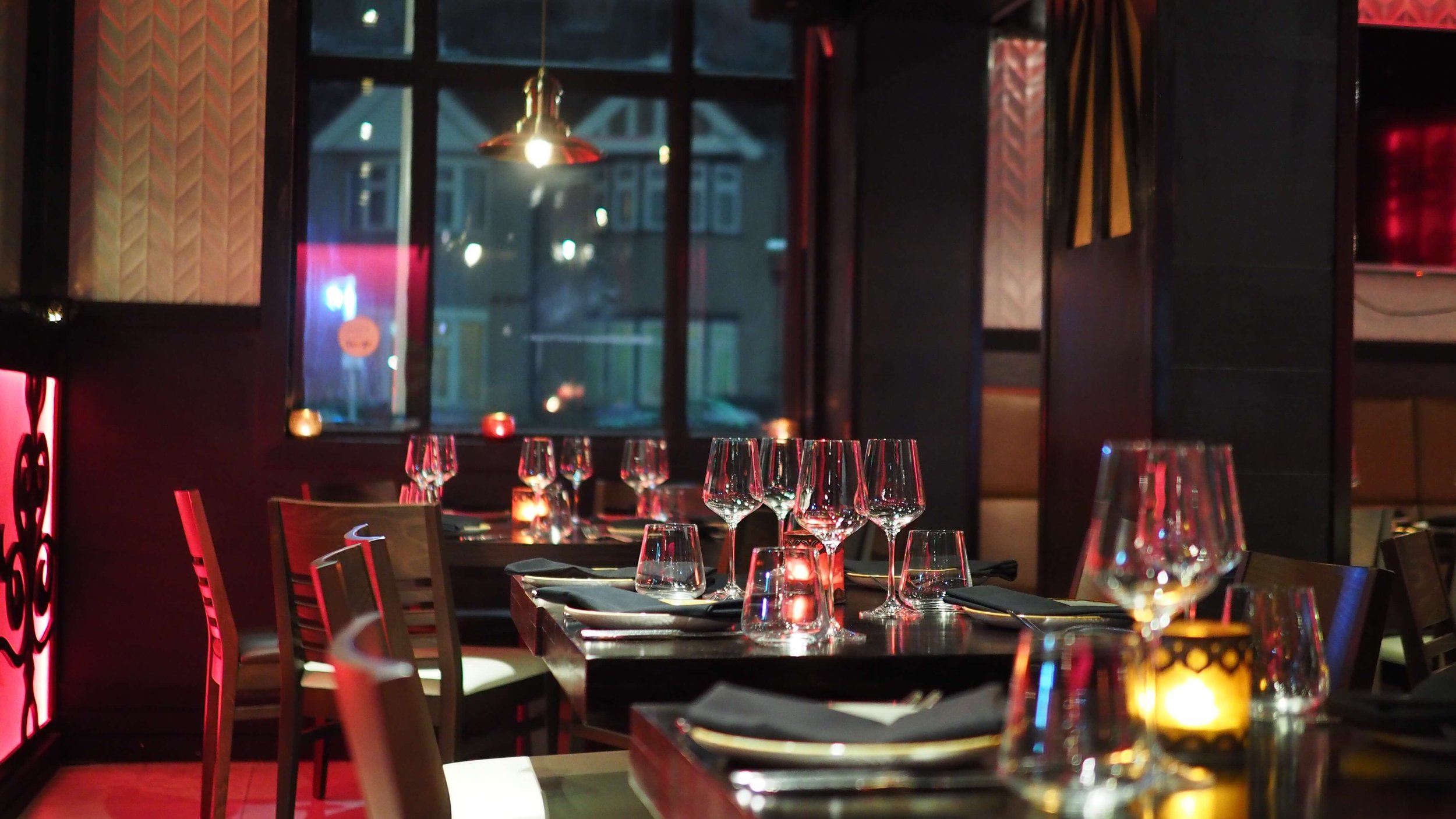
Developing a Restaurant Concept
Now that you know what a restaurant concept is and why it's important, it's time to start developing your own concept. Here are a few tips to get you started:

Define Your Restaurant's Target Market
Before you can start developing your restaurant concept, you need to define your target market. Who are you trying to attract? Are you targeting families, millennials, business professionals, or a mix of all three? Once you have a good understanding of your target market, you'll be able to start developing a concept that appeals to them.
Choose a Theme or Cuisine
One of the most important aspects of your restaurant concept is the theme or cuisine. This will be the foundation of your business, so it's important to choose something that you're passionate about. Do you love Italian food? Are you a history buff? Do you want to create a restaurant that's family-friendly? Once you've decided on a theme or cuisine, you can start planning the rest of your restaurant around it.
Consider the Restaurant's Atmosphere and Décor
The atmosphere and décor of your restaurant should match the concept you've chosen. If you're going for a casual, laid-back vibe, your restaurant should be decorated accordingly. On the other hand, if you're going for a more upscale, fine dining experience, your restaurant should be correspondingly elegant.
Develop a Menu that Matches Your Concept
Your restaurant's menu should be consistent with the overall concept. For example, if you're running an Italian restaurant, your menu should be filled with classic Italian dishes. If you're running a theme restaurant, make sure that your dishes are clearly connected to that theme. When developing a menu, you'll also need to think about the capabilities of your kitchen staff and where you'll be sourcing ingredients from.
Choose a Name and Logo that Reflect Your Concept
Your restaurant's name and logo should be reflective of the concept you've chosen. They should be eye-catching and memorable so that potential customers will be able to easily recall your restaurant when they're looking for a place to eat.
Promote Your Restaurant Concept to Attract Customers
Once you've developed your restaurant concept, it's time to start promoting it to attract customers. You can promote your restaurant through advertising, social media, word-of-mouth, and other marketing channels. The key is to get the word out about your restaurant so that potential customers are aware of it and will want to check it out.
DMD Restaurant Consultants Can Help Develop Your Next Restaurant Concept
Do you have big plans for your restaurant, but aren’t sure how to make them come to life? Contact DMD Restaurant Consultants today. I can help you develop a concept that is unique and profitable, while fulfilling your original vision. I am experienced in business planning, menu development, restaurant operations, and more. Whether you want a guide throughout the entire process of opening a new restaurant or just need support in key areas, I have the resources and knowledge to help you succeed.
How to Increase Food Sales in a Restaurant
A guide to menu development.
How to develop a restaurant concept plan

A restaurant’s concept is the lifeline of its brand and longevity in the market. It makes your venue stand apart from the competition, and it’s ultimately your restaurant’s unique selling proposition.
A concept plan is something every aspiring restaurateur should look to complete. Due to the high level of risk for independent restaurant related start-ups, it’s wise to take advantage of every planning step possible.
Here are a few things to consider when developing a concept plan.
An idea is not a concept
The ‘idea’ one has needs to be articulated and deeply researched through the completion of a feasibility study . Once that idea has been researched and the market, location, technical, business, and financial viability of the idea has passed a series of reviews, a concept plan can then be started.

Keep these characteristics in mind
When first developing a winning concept, there are five key characteristics an aspiring restaurateur needs to keep in mind. The concept must be designed to be scalable, profitable, memorable, consistent, and sustainable. If you can apply these five characteristics to each stage of the decision making process, you will be positioning yourself for success!
It’s more than cuisine
Most conceptual ideas start at the food or cuisine level. New restaurateurs need to remember that restaurants don’t just sell food and beverages; they sell experiences through the enhancement of guest emotions. When planning a concept, it’s imperative to have a focus on the style of menu and niche of cuisine, but it needs to be taken a step further to ensure it’s a menu that the market not only wants and needs, but a menu that elevates the guests’ variety of senses.
Incorporate your choice of messaging
The development of a brand is much more than color choices and logos. One of the best ways to begin laying out your brand’s messaging is to complete a vision, value, mission, and culture statement. Walt Disney once said: “when your values are clear to you, making decisions becomes easier!” This is also incredibly true when it comes to restaurants.
Once you know your values and other statements, and have refined them to be simple, memorable paragraphs, then you, your future staff and your community will truly understand your concept. It will also allow you as an owner-operator to make clear, educated decisions, in terms of further design attributes, business financing decisions, and the hiring of a team, that meet your values and messaging – something that will assist in controlling future labor costs.
Develop a budget
Building, buying, or renovating a restaurant is often not a cheap endeavor. The largest cost factor is going to be the construction and renovation period.
At the concept development phase, it’s crucial to gather as much information as possible in terms of your desired design features and vision. Are you in a financial position to develop the restaurant to your desired vision? If not, find ways to scale back in terms of size and decor while still matching the concept you want to deliver. If scaling back, can the restaurant still meet projected financial goals set-out in the feasibility study? Can the kitchen still produce the proposed menu?
Learn how to present your concept
If you need further funding or are preparing to meet with designers, architects, or consultants, creating a presentation to pitch your concept (after a business plan is written) should also be considered. Keep in mind, as much as you’re selling the restaurant concept and explaining the gap it will fill within the market, you are also selling yourself. This is the opportunity to tell your story — a great way to start your presentation. Show your passion for food, beverage, hospitality, and general business.
One final item to remember is that investors are looking for opportunities that present themselves in regards to scalability, profitability, consistency, and sustainability as well. Make sure these characteristics are visible in all aspects of your concept presentation.
A winning concept goes far beyond culinary trends, and assists with the development of your menu, design, and overall branding strategy. Once your concept plan is complete, it’s time to write a strategic business plan, the third plan in the overall planning process.
You might also like
Topics: Hospitality operations , Hospitality managers , Restaurants
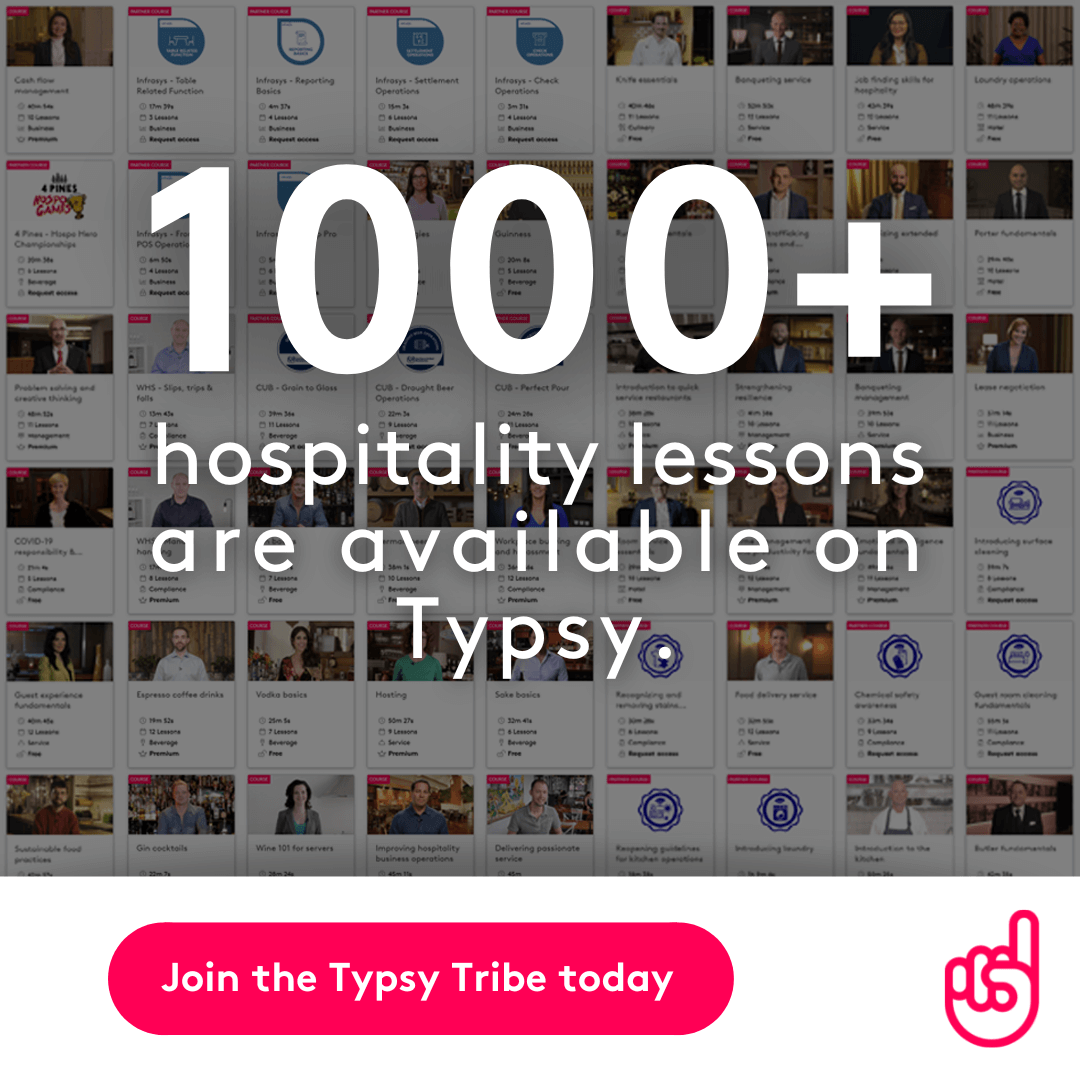
About Typsy
Browse by category
- Case studies (7)
- COVID-19 (41)
- Cybersecurity (1)
- Expert Q&A (10)
- Health and wellbeing (49)
- Hospitality career tips (109)
- Hospitality courses (1)
- Hospitality insights (159)
- Hospitality managers (314)
- Hospitality marketing (134)
- Hospitality operations (109)
- Hospitality recruitment (1)
- Hospitality skills shortage (8)
- Hospitality staff (188)
- Hospitality technology (1)
- Hospitality training (103)
- Hospitality trends (11)
- Hotels (259)
- Onboarding (1)
- Online hospitality training (2)
- Restaurants (292)
- Schools (23)
- Travel & tourism (4)
- Typsy updates (101)
Recent posts
Search this blog.
- There are no suggestions because the search field is empty.

Find the right Typsy plan for you
For job seekers, casual workers, university students, travelers and career builders, for businesses and teams of any size.
How to Make a Restaurant Concept Statement
- Small Business
- Business Technology & Customer Support
- ')" data-event="social share" data-info="Pinterest" aria-label="Share on Pinterest">
- ')" data-event="social share" data-info="Reddit" aria-label="Share on Reddit">
- ')" data-event="social share" data-info="Flipboard" aria-label="Share on Flipboard">
How to Start a Tapas Bar
How to be successful in opening a barbeque restaurant, how to set up a facebook page for a restaurant.
- Modern Concepts in the Catering Industry
- The Importance of a Restaurant's Name & Their Specialty to the Success of the Business
Food is deeply personal, and the menu items you serve at your restaurant likely will be based on what you love to cook and eat. You can describe your food concept as simply being about your own tastes and experiences, but you'll have a better chance of attracting investors and customers if you focus your concept and articulate it clearly for a broader customer base.
">Narrow Your Focus
The more focused your restaurant's concept, the easier it will be to develop a concept statement. If you offer foods from your own region, you'll be better able to describe what you do and why you do it, than if you make foods from all over the world. Start your concept statement by describing what kind of food you've chosen to make, and how the trappings of your restaurant will reflect the emphasis you've chosen. The more clearly you are able to describe the direction you plan to take, the more likely you'll be able to gain the confidence of investors, and of customers.
Writing Your Statement
A restaurant concept statement is an important part of the business plan that you will present to potential partners, bankers and investors. Writing it is also a valuable exercise that will help you clarify your thoughts. Keep your audience in mind when you draft your statement. If you're pitching to bankers or investors, emphasize the potential for profitability.
If you're approaching a potential partner who loves to cook, stress the culinary opportunities. Use as many words as you need to communicate your meeting but don't make it any longer than necessary. Describe the ways your concept will be reflected in every aspect of your restaurant – from the food, to the service, to the decor to the prices. If you haven't already given these details careful thought, take the opportunity to do so at your earliest convenience.
Using Your Concept Statement
In addition to being part of your business plan or sales pitch, your restaurant concept statement should be a guiding vision that helps you create an end product that customers understand. Refer back to it when making decisions about everything from decorating to training to marketing. If you're starting a farm-to-table restaurant, this concept should be reflected in agriculturally themed decor, and your servers should have detailed knowledge of the farms where you've sourced your ingredients. Your marketing materials should also be infused with this focus, by naming farms and origins, and by using agricultural motifs.
- Webstaurant Store: Choosing a Restaurant Concept
- All Food Business: Restaurant Concepts
Devra Gartenstein founded her first food business in 1987. In 2013 she transformed her most recent venture, a farmers market concession and catering company, into a worker-owned cooperative. She does one-on-one mentoring and consulting focused on entrepreneurship and practical business skills.
Related Articles
What is a concept description in terms of a restaurant business, how to describe your company's products and services, how to start a food business from home, how to do a restaurant proposal as a manager, what is a statement of purpose for a restaurant, how to own & manage a fast food restaurant, how to develop a restaurant concept sample plan, how to write a restaurant proposal, surviving as a restaurant in a small town, most popular.
- 1 What Is a Concept Description in Terms of a Restaurant Business?
- 2 How to Describe Your Company's Products and Services
- 3 How to Start a Food Business From Home
- 4 How to Do a Restaurant Proposal as a Manager
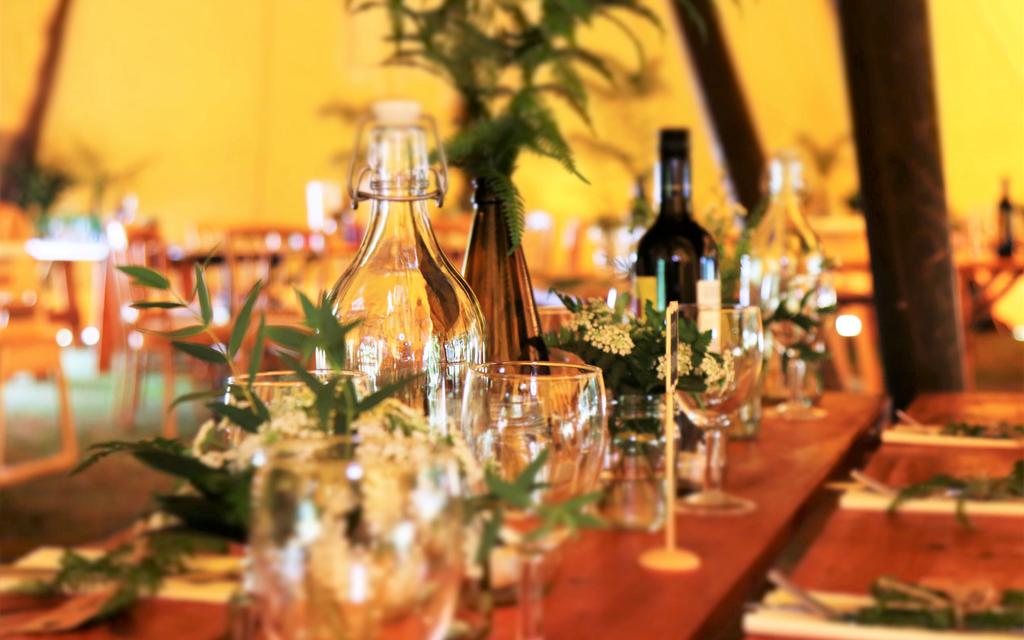
Restaurant concept: Importance, how to choose or create one.
Learn the importance of a restaurant concept, how to pick one, or create one.
When you want to open a restaurant, a bar, or a cafeteria, you must understand several things before starting. For example, you must know a little about marketing, a little about management, and more. But you should also know the definition of a restaurant, the concept of a restaurant, and the theme of a restaurant, and their differences — although these last two are very similar.
In this article, I will talk to you about:
- The definition, the concept, and the theme of a restaurant.
- The importance of the concept of a restaurant.
- How to choose the concept of your restaurant, if you will choose an existing one.
- And how to create the concept of a restaurant from scratch.
In addition, this article will help you to deeply understand these ideas, to understand how the concept of a restaurant satisfies the guests, and how you can optimize your own concept.
This is great if you intend to start your own restaurant soon or if you want to improve your current restaurant. Let's get started!
What is a restaurant?
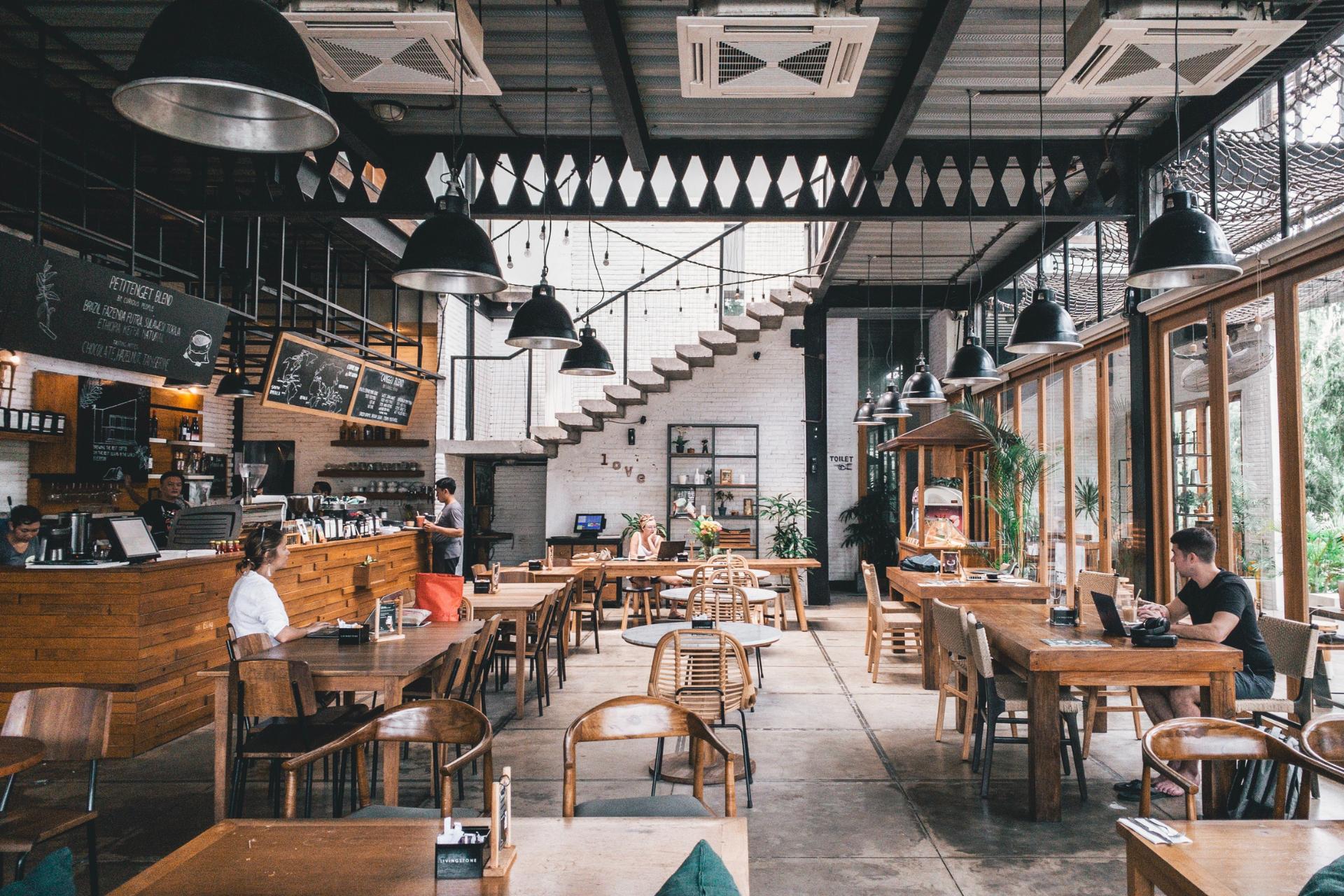
First, I'll give you the definition of a restaurant . This is important, especially because of the similarity of the meaning between the word "definition" and "concept".
A restaurant is a service establishment whose objective is to prepare and sell food and drinks to satisfy customers. Also, a restaurant is responsible for offering other amenities to customers, such as table service, home delivery service, optimal payment methods, and more.
Of course, that is a rather narrow definition , as it leaves out other aspects of the restaurant that I can easily delve into when defining the concept of a restaurant .
What is the concept of a restaurant?
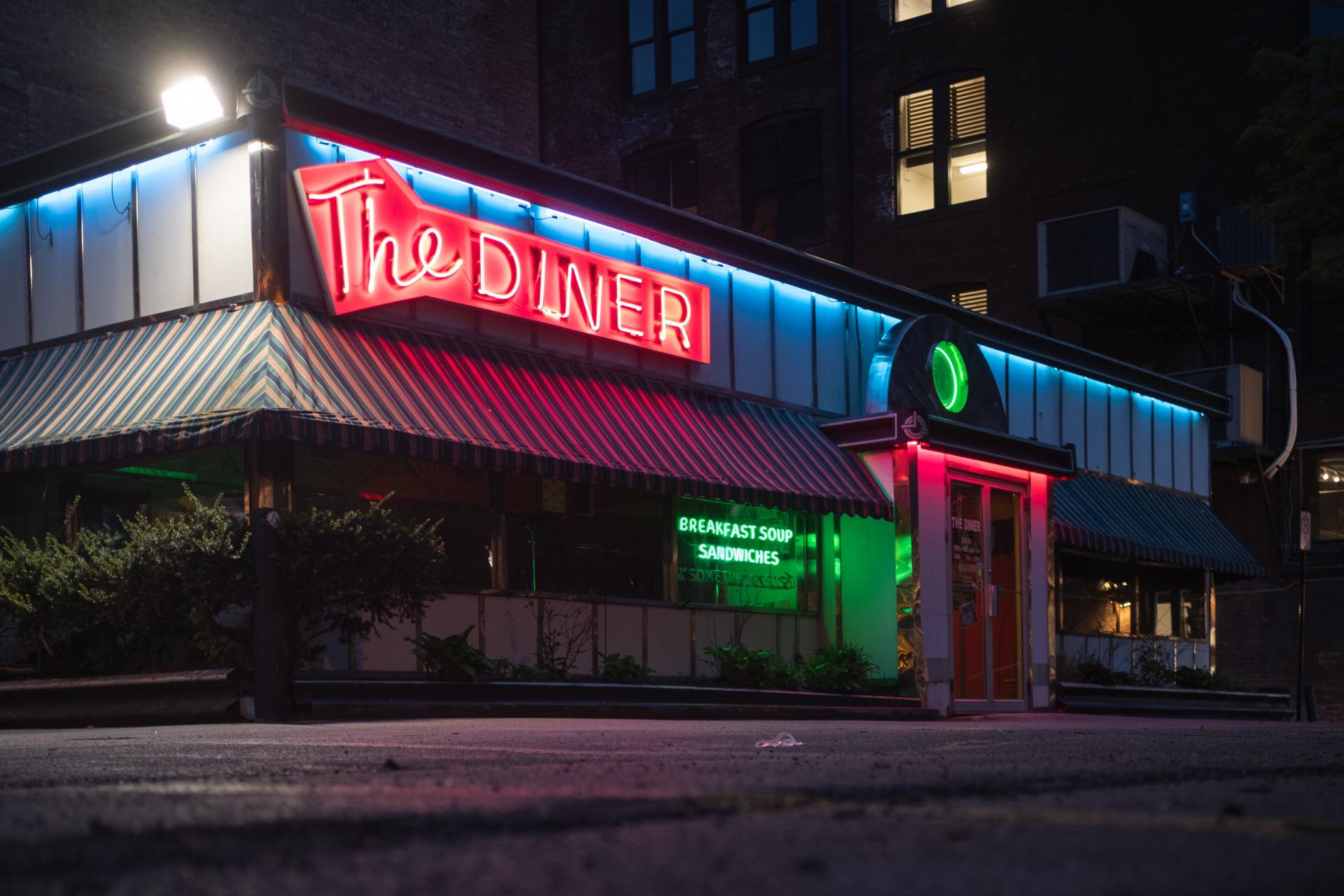
Very briefly, the concept of a restaurant is all that it is, all the experience that it offers .
This is not only limited to culinary style and service style. Rather, it is about the numerous details that are defined based on those elements. For example:
- The culinary style (for example, fusion cuisine, Asian cuisine, etc.) defines the equipment you will need, the ingredients used, the flavor of the food, the plating, the cutlery, the pairing, and even the napkins.
- The style of service defines the training of your servers, the type of customers the restaurant is aimed at, the treatment they receive, and even if your restaurant receives tips or not.
- The decoration and physical layout of your restaurant define the lighting, colors, atmosphere, the number of customers you can serve, the dress code, and more.
- And more key elements of your restaurant, such as the point of sale, the organization of your kitchen, the number of employees, etc.
That is why the concept of your restaurant is the compendium of actions, decisions, techniques used in your restaurant to satisfy your customers. Also, at a basic level, everything that affects your customers and the experience you offer is part of your concept regardless of whether it affects them on purpose or not .
That doesn't sound all that complex, but it gets tricky when you realize that it means that even restaurants that don't seem to have a concept actually do have one. It is more difficult to define what the concept of a restaurant is due to the variety of techniques and practices that can be called as such.
In addition, the concept also has weight in many aspects of your restaurant, such as marketing, the strategies that you apply, the reputation of the restaurant, the type of clients that you attract — that is why it is complex to know where to start to create the concept of your restaurant from scratch.
What is the theme of a restaurant?
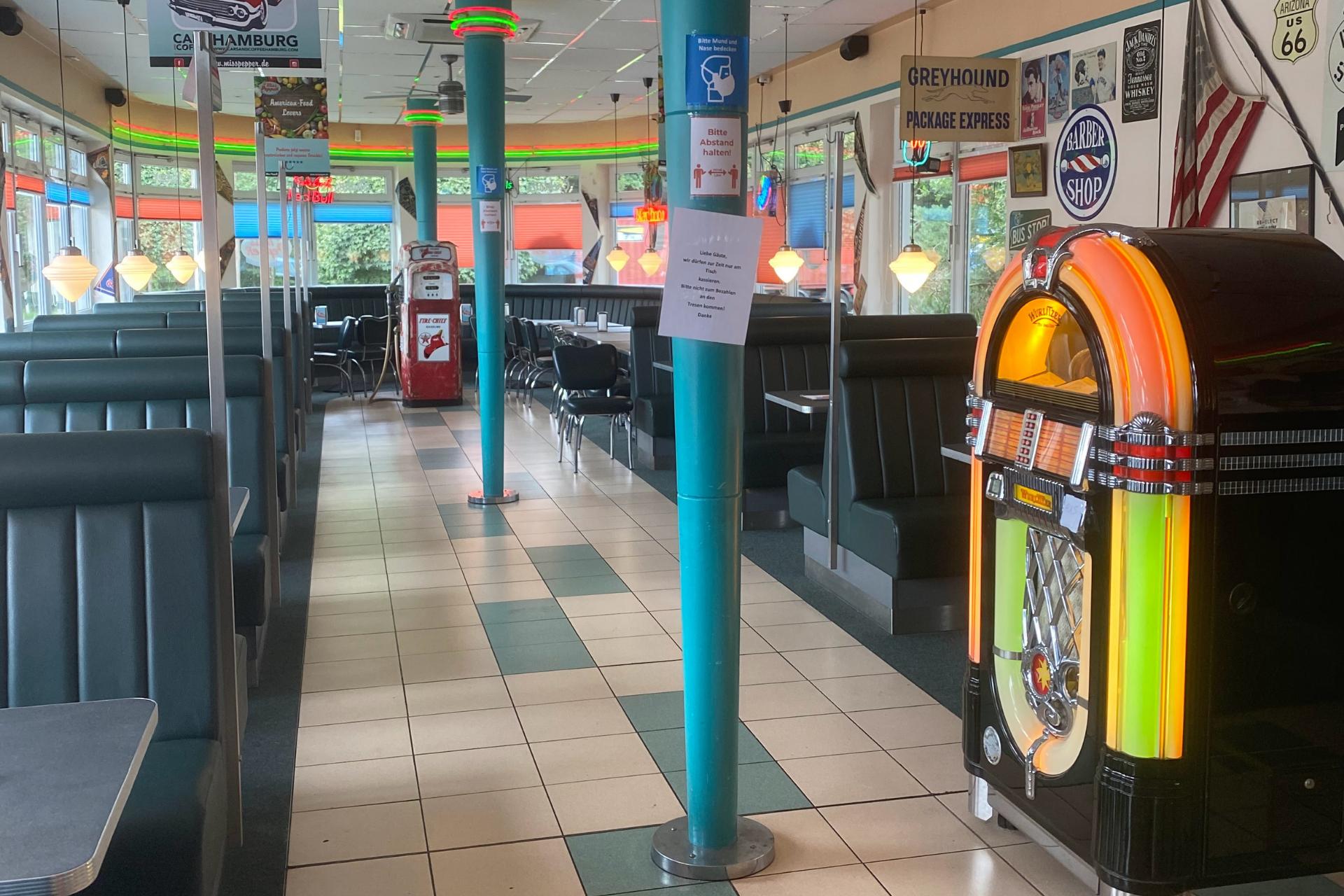
The theme of a restaurant is similar to the concept. However, a theme works in reverse, since the theme is sometimes chosen before defining the concept in its entirety.
A theme can be anything.
A Caribbean beach-themed restaurant works to deliver a Caribbean dining experience — that's the theme.
The concept of that restaurant would be defined by different details of the kitchen, the style of service, and other convenient details to offer that experience. For example, drinks served in coconuts, imported silverware and cutlery, culinary styles and traditional cooking techniques, exotic ingredients, and more. Those might sound like clichés, but that's actually part of the joke of a themed restaurant .
The theme of a restaurant is closely related to its concept — it could be said that all restaurants have both .
Importance of a restaurant’s concept
The concept of your restaurant is vital because it is basically the limitation that you put on your restaurant in terms of profitability, target customers, and more details related to finances.
It is also important to define your concept along with your business plan . If you change your concept, you will need to start the planning process all over again and make changes to absolutely everything so it’s in line with the experience you want to deliver with your concept.
The areas you should plan to coordinate with your concept are:
- Naming the dishes to reflect the restaurant concept
- Choosing the nuances and décor of the dining room for your concept and target audience of guests.
- Source foods for your concept, such as choosing farm-direct suppliers, low-cost processed foods, organic ingredients , or high-end meats and produce.
- Use electronic signs, dining room art, and physical signs to keep your concept going.
- Training your staff to provide the right level of service, such as teaching waiters about fine dining wines.
- Give the restaurant a name to indicate your concept.
The most important thing is to design your menu to attract customers looking for the experience you offer. Other important management considerations for promoting your concept include:
- Satisfy customer expectations, such as implementing a dress code for fine dining establishments.
- Develop the menu as your central document so that you can refer to it when making other decisions.
- It offers a constant experience in each visit.
- Plan special events that harmonize with the concept.
Some restaurants offer separate dining experiences in different parts of the restaurant. For example, bars often present a different concept than the rest of the business. However, you should tie these differences together with a common conceptual thread, such as ingredients from similar or common origins, offering the same service quality, and more.
How to choose a restaurant concept?
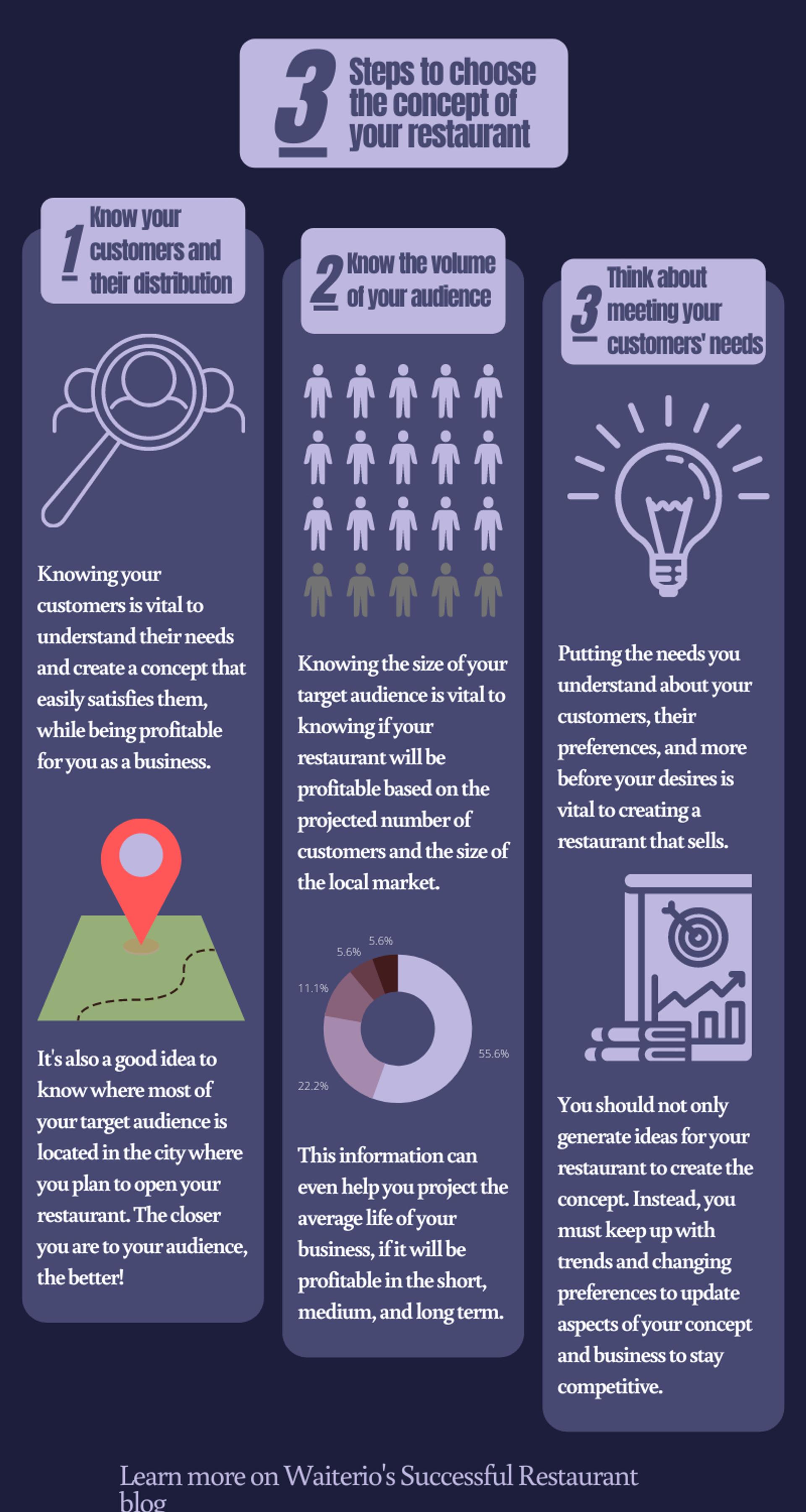
Now you should know why choosing a restaurant concept is difficult, even for experienced restaurant owners.
Unfortunately, choosing a restaurant concept is not something you should do based on instinct, culinary knowledge, and skills . Even passion can be overrated in businesses ..
Just think of the number of failed restaurants that have delicious, innovative, and great food, with skilled, passionate, and even famous chefs , and entrepreneurs who saw the opportunity to start a business.
There are too many to hide — I'm not trying to quench your passion or desire to undertake.
But why does that happen?
Because even if your concept is amazing, if you can't attract enough people who are willing to live the experience you offer, your restaurant will fail.
Those chefs and restaurant owners didn't fail because of a lack of experience or skills — it's because they didn't understand their diners, their needs, and the size of their target audience .
What is the solution?
In fact, there are three solutions that you must apply at the same time to choose the most suitable concept for your restaurant:
- Know your customers.
- Know the volume of customers in your area.
- And internalize and put their needs before yours with every aspect of your restaurant from the beginning.
That is why restaurants with low prices that offer a balance between quality and price don’t fail so often.
These types of restaurants know their customers better, they prioritize the main need to eat without spending so much money, and they know that more people have less money to eat out.
And on top of that, they treat those customers well because they know the value of customers .
Obviously, it's not a rule to create restaurants that only attract people who want fast, cheap food and decent service.
In fact, even sticking to those three solutions won't guarantee your success — your restaurant can always fail for many reasons, like lack of capital, management issues, and more.
But you should always focus on understanding those three aspects and choose your restaurant concept accordingly to maximize your chances of success.
There are exceptions, for example, if you have an idea for a concept that you think will revolutionize the industry and create history .If that's the case, I recommend you keep reading .
Note: Another interesting thing to know is that you can never pick a concept and copy it in its entirety. If you make a minor change to any aspect of your restaurant, you will technically have created a new concept.
How to create a restaurant concept from scratch?

What if you have a restaurant concept in mind that you think will be so revolutionary that it will mark your name in history? I won't be the one to tell you it's not possible — we sure need what you have in mind!
So, now I will give you a simple guide on how to create a successful restaurant concept using the ideas that I have mentioned above.
1. Study your motivation and goals

Although you should put your customers' needs first at all times, it's a good idea to review the motivation behind your business. After all, this will affect how well you apply all three solutions later on.
If you want to create a new concept, you may be an experienced and passionate cook or chef. But, it is also possible that you are an entrepreneur with a good business vision.
Regardless of that, you need to understand your own motivation for opening a restaurant, and of course, set your goals based on that. By the way, your goals may be different from the goals of your restaurant .
For example, if your motivation is the need for money, and your goal is to earn it rather quickly, you may not be able to open a restaurant with a particularly expensive concept.
On the other hand, if your motivation is your passion, and your goal is to satisfy a specific target audience with refined tastes who appreciate your skills, opening a regular fast food restaurant would not be ideal.
This step won't take you long — you probably have your motivation and goals in mind at all times.
But it is very important that you take it into account to know what type of concept is more in line with your personal motivation, and brings you closer to your goals.
2. Study and understand your clients

As we mentioned earlier in our restaurant marketing article , the first thing you need to do to create effective strategies is to know your customers . And, of course, the same applies when it comes to understanding your customers to create a concept.
Studying your customers is about internalizing their needs, what they really want, and understanding if your concept is likely to satisfy them. That is why it is important that you do a local market study .
This is vital for you to build your restaurant concept around the needs you discover from the local public.
Of course, you should also take into account the previous step. But, if your motivations and objectives are not aligned with the needs of the target audience of the place where you want to open your restaurant, you will not be able to connect with them.
In that case, instead of taking the risk and investing, it is more convenient to consider one of these decisions:
- Ignore your motivations and objectives and create a concept that is based solely on the needs of your clients.
- Or change the area, city, county, or even country to find a target audience that can really help you meet your motivations and goals.
Making this decision is not very easy for everyone, however, it is easier when you understand that making the wrong decision will determine the success of your restaurant.
Again, this is not the final nail in the coffin for your concept — you should simply view it as a business decision.
3. Study the size of your target audience

This third step is also crucial — you can't build a business if you don't know how many clients you have access to.
It is possible to think that you can understand the distribution of the different target audiences in your city. However, this information is not completely objective — you will only see what you have access to the most.
For this reason, it is highly recommended that together with the market study, you carry out a census of the people who are part of your target audience and that you also carry out a study of the geographical distribution.
This is very important because:
- You must know if the volume of your target audience in a city or area is enough to keep your restaurant profitable and competitive.
- And you should know where that target audience is most concentrated in the city where you plan to open your restaurant.
This is the reality behind the motto location, location, location, and its application in the restaurant industry.
It's not a good idea to place an ordinary family restaurant in an expensive area of the city.
It is also not a good idea to place an expensive restaurant in an area with fewer resources.
This is just common sense, but carrying out a census and a market study will help you prove it with evidence.
The truth is that you can open a restaurant anywhere in the world and be successful if you study these two aspects and create your concept accordingly.
4. The last step is for you to start creating your concept
Yes, that's right, you shouldn't even start planning your concept before completing the steps above — at least not if you want to maximize your chances of succeeding the first time.
Once you understand your motivations and objectives, the needs, the volume, and the distribution of your target audience, you can begin to define the following aspects:
- The type of service.
- The cuisine and the type of menu of your restaurant.
- The theme, if you have one.
- The location of your restaurant .
As I mentioned before, these elements will, in turn, define other details, such as your branding strategy, marketing strategy, decoration, the equipment you will need , the employees you will need, the organizational chart of your restaurant , and more.
The concept of your restaurant is vital
There is no doubt that the concept of a restaurant is vital to its success. That's why you should start thinking about the concept even before you write your restaurant business plan.
As I mentioned above, getting the concept right is not something that is independent of your target audience. Instead, you should create the concept of your restaurant based on your target audience, its volume, and based on the location of the restaurant.
Is your concept in line with the needs of your target audience? Hope so!

I am a restaurant chef with many years of experience in cooking for restaurants. I have owned 'Buddy’s Restaurant' in Roanoke, Virginia, for many years. I am here to share my experiences and help new entrepreneurs in the food business.
Join 40,000 restaurants using waiterio point of sale system
The online ordering has been the perfect tool, especially with the ongoing COVID-19 pandemic as customers choose to limit face to face interaction. We have grown food delivery by over 112% which is solely due to the use of the free online ordering website.
- Matthew Johnson (Owner of MrBreakFastJa , Jamaica)
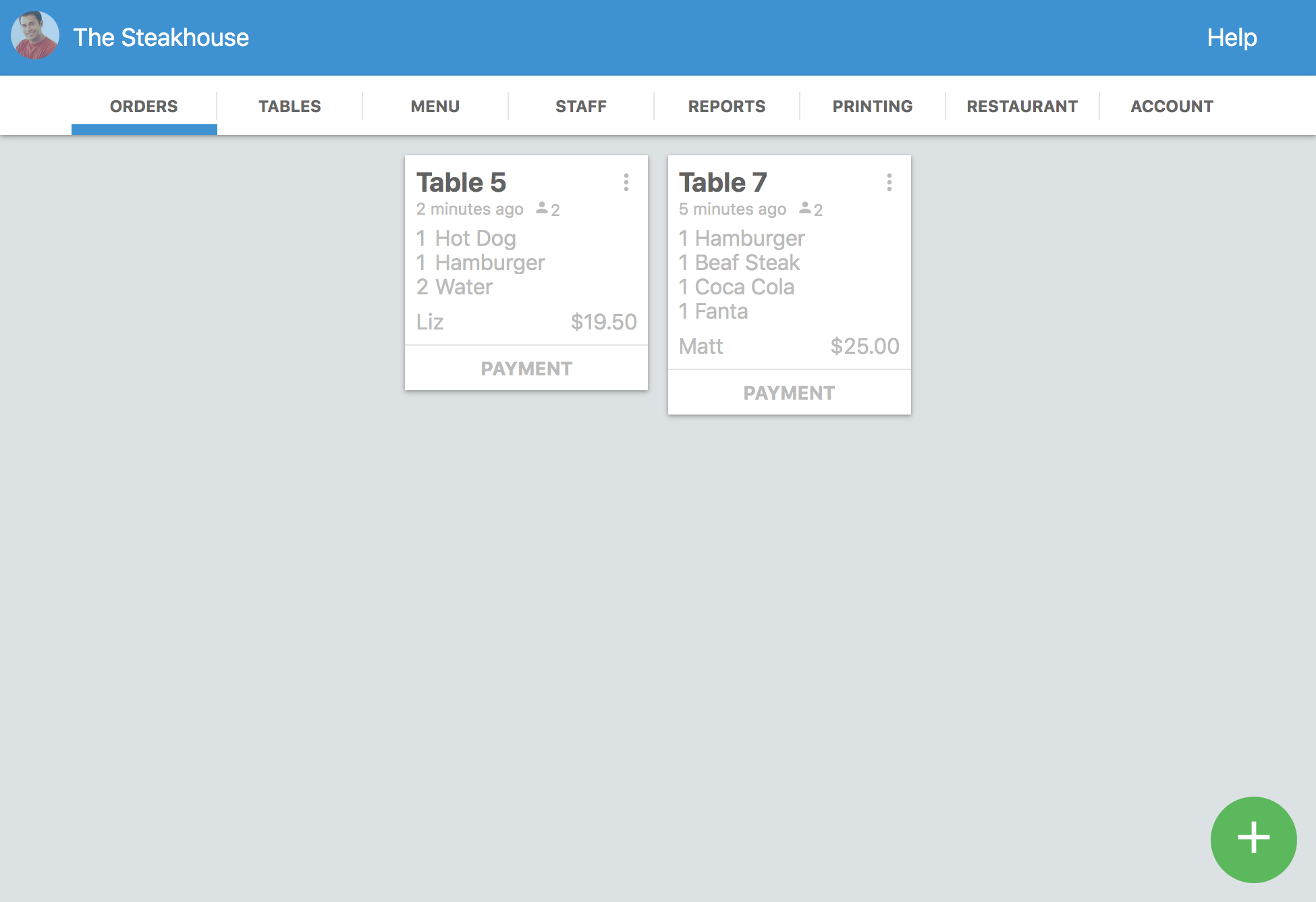
Recent articles
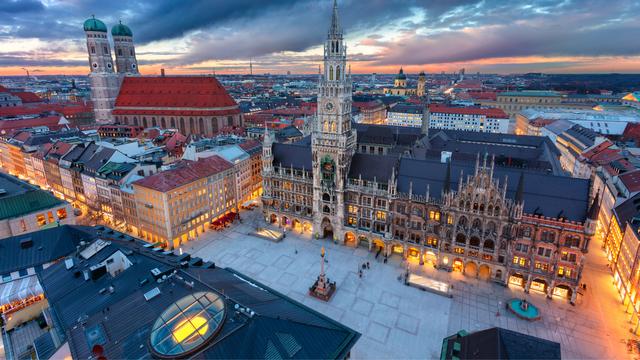
JavaScript seems to be disabled in your browser. For the best experience on our site, be sure to turn on Javascript in your browser.
- Payment & Delivery
- Ukraine Recovery
- For Government & Fortune 500
- (718) 369 0600
- Mon-Fri: 7:00am - 6:00pm Sat: 8.00 am - 2.00 pm
- Information
- Compare Products
- My Wish List
- Create an Account
- McDonald Paper Blog
Unique Restaurant Concept Creation Guide
Winning concept is vital for a new restaurant's marketing. There are millions of food serving establishments in the United States, and your restaurant or bar concept may already exist somewhere.
New concepts are hard to formulate, but it's possible with the right approach.
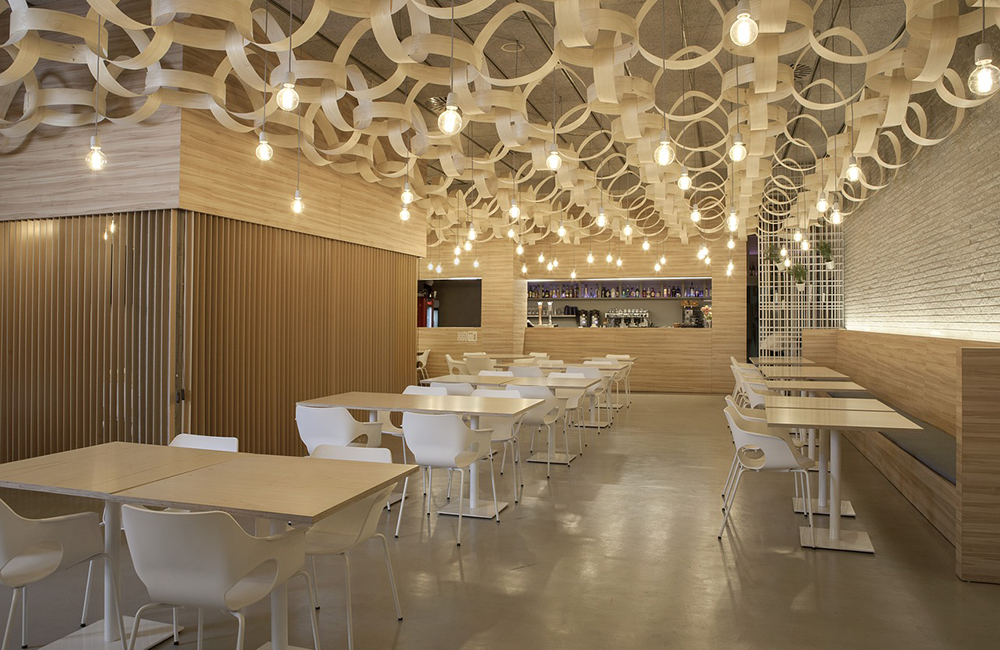
Brainstorm Your New Restaurant Concept
Either you're starting a new establishment, or revamping a current dining concept, your winning idea needs to:
- Fit perfectly with the neighborhood
- Meet a demand
Brainstorming is a great place to start, and this means:
- Taking notes of all of your random ideas
- Creating scrapbooks with images and notes
- Taking pictures and jotting down ideas on your phone
Start the brainstorming process early so that you can have a lot of potential ideas that you can choose from in the future. A lot of the ideas will be discarded, but you need those few nuggets to be able to build off of when the concept starts to come together.
Make sure you:
- Conduct a lot of research
- Study the market
- Look over current trends
Don't expect your idea to pop up overnight - it takes time.

Tour Other Restaurants for Inspiration
When you're looking for inspiration, it's never a bad idea to go to other restaurants and see what different concepts they may have. Plan a trip to the city or a rustling location where you can drop in a restaurant for a drink and draw inspiration from their concepts. If you want to take it a step further, take pictures and keep all of these ideas for later.
A lot of the most successful concepts started on the inspiration of another restaurant. Perhaps you like this one concept, but you have such a great way to improve upon it. You can improve on the concept and make it your own if you wish.
You can also take this time to mix and match ideas to come up with your own unique restaurant concept.
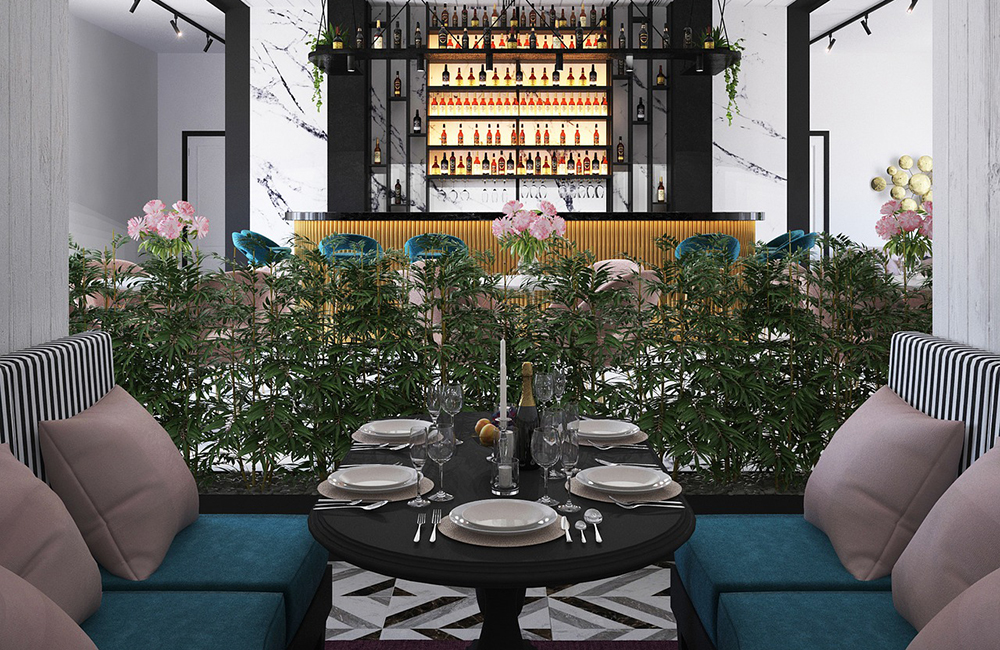
Go Beyond the Theme and Concept of the Restaurant
Quality restaurant concepts fail when there's not a strong plan in place. A lot of hurdles will be experienced during the initial few months of the restaurant's operation. One major issue in restaurant concept development is that individuals assume that "concept" only relates to the theme and aesthetics of a restaurant.
Unfortunately, there's a lot more that has to go into your overall concept.
Successful restaurant concepts include:
- Plans for the initial months of operation
- Theme of the restaurant
- Market research
- Location and design
You'll effectively use most of your business plan as the concept for the restaurant. Using the points above, you may have a good idea of what you want the restaurant's aesthetics to look like.
But now it's time to:
- Research . You need to know your market to ensure that your establishment will be a success. Research the competition, make sure that there isn't too much competition (it leads to business failure) and determine the food and supplies you'll need to find success.
- Location and design . Where will your location be? A city's main street is always a great choice, but if your restaurant is at the end of the street, it may not receive the same foot traffic as a restaurant in the middle of main street. Consider parking, traffic and demographic. A restaurant serving $80-per-plate meals will not work well in an area where the average resident earns $20,000 a year.
Another question is what will you offer to your customers in terms of service? Will you offer:
- Sit-in dining
- Drive-thru windows
If you're in a small town with little competition but high demand for Italian cuisine, the idea of delivering may be a unique concept for your area. There are a lot of different types of restaurant concepts, so choose one that meets your audience's needs and your own wants.

Understand and Determine All Elements of Restaurant Concepts
If you want to know how to make a restaurant successful, it comes down to all of the elements of a concept. A concept may include the following:
- Restaurant Name . A name should give a potential patron a general idea of what type of food your restaurant serves. You would expect a restaurant named "Steakhouse" to sell steak. "Dolce Vita" would be expected to be an Italian restaurant.
- Menu Writing . When a patron sits down and reads your menu, will it pinpoint the high-end ingredients, explain the savory flavors with precision details or will the menu be fun? The menu should make sense for your ideal customer and restaurant style.
- DГ©cor and Ambiance . The dГ©cor and ambiance of a restaurant should have already been part of your brainstorming session. You'll want to determine everything, including how the ambiance should be. Should the ambiance be romantic, or will you be offering a more casual dining experience? A few of the main elements to focus on here are:
- Table settings
Restaurant atmosphere types are dependent on the dГ©cor and ambiance that you choose. Bar concepts can be fun, or they can offer more of a sports bar feel that is one of the best restaurant concepts in college towns.
A lot of restaurants with bars are trying to stand out from the crowd. An Irish pub with a true Irish concept with imported bars and seating are very popular in some areas.
Choose how you would like your restaurant's concept and run with the idea. Make sure that the restaurant has a place in your area first. Classic restaurant concepts work well because they appeal to a wide range of consumers. But if you choose a concept that is too unique, it may put off some potential customers.
You need to have a pulse on the food service concepts in your area.

Examples of Unique Restaurant Concepts
A winning concept is going to be highly dependent on your location and its respective demographic. High-end restaurants may work well in affluent areas, but the restaurant will not work well in an area riddled with poverty.
There are a lot of concept examples that work well, but a few options are:
- High-end establishments put a major focus on the dГ©cor, lighting and other areas of the restaurant that scream "fancy." You'll need to have a cohesive design concept throughout and also a chef that is able to bring the restaurant's food up to the quality that is expected of a Michelin star establishment.
- Mashup establishments are a lot of fun, and it's these restaurants that may offer French or Italian food, but they have a relaxed environment. Wacky dish styles or dГ©cor may be used in these restaurants.
Of course, there are also the very unique restaurants that make a splash in a neighborhood. I remember one restaurant near my old house that didn't have the best food in town, but what they did have was a parking lot filled with patrons. The restaurant was able to bring in crowds by having all of the staff dress up as characters from blockbuster movies.
Having Jack Sparrow serve you dinner with his unique style was a lot of fun, and it was a concept that worked very well in a busy city where people wanted to escape the hustle and bustle of life. Keeping your concept running well means running a business properly. One main question you have to ask yourself is: will the concept make sense in three years?
Don't create a concept that will be short-lived. Concepts should be able to be used today and ten years from now. Restaurants often adapt and change concepts over time, but you don't want to have to go through a concept change too often.
A few other key business decisions you'll need to make are:
- Securing enough suppliers to help you obtain specialty goods
- Focus on cash flow, especially when making large purchases
- Have backup plans for ingredients that may be unavailable
- Hire chefs that are able to bring your restaurant to life, and always have recipes available to keep the same taste and quality if a chef quits
Consistency is key. You may find your business is running well, but then in the slow season, your food waste and expenditures are barely covered. New restaurants should keep a close eye on these slow seasons so that they have a better idea of when to cut back on expenditures.
Adapt as the times change, and you'll find that your restaurant concept is not set in stone.
Staff and chefs need to be in on key business decisions. Work as a team to bring your concept to life and to help keep your restaurant running successfully. If you have a firm grasp of the financials of the restaurant and also work with consultants when times are rough or you have questions that go unanswered, you'll be able to make your business a success.
It is easy to start a restaurant, but it's difficult to keep a restaurant operational. Choosing a winning concept is the first step in making your restaurant a success, but longevity also depends on your restaurant's ability to adapt and change with market demands.
- Start & Manage a Restaurant
- Restaurant Financials
- Menu & Pricing
- Restaurant Staff
- Equipment & Supplies Management
- Marketing & Promotion
- Restaurant Design
- Software & Tools
- Cheapest Franchise to Open in 2024 May 28, 2024
- How to Make a Menu Profitable with Advanced Menu Engineering May 22, 2024
- What is WiFi Marketing for Restaurants and How Does it Work? May 15, 2024
- 2024’s Commercial Grills Review: Options for Restaurants May 7, 2024
- How to Manage Your Restaurant’s Labor Costs May 1, 2024
- 10 Social Media Marketing for Restaurants Ideas in 2024 Apr 24, 2024

Concept Papers in Research: Deciphering the blueprint of brilliance
Concept papers hold significant importance as a precursor to a full-fledged research proposal in academia and research. Understanding the nuances and significance of a concept paper is essential for any researcher aiming to lay a strong foundation for their investigation.
Table of Contents
What Is Concept Paper
A concept paper can be defined as a concise document which outlines the fundamental aspects of a grant proposal. It outlines the initial ideas, objectives, and theoretical framework of a proposed research project. It is usually two to three-page long overview of the proposal. However, they differ from both research proposal and original research paper in lacking a detailed plan and methodology for a specific study as in research proposal provides and exclusion of the findings and analysis of a completed research project as in an original research paper. A concept paper primarily focuses on introducing the basic idea, intended research question, and the framework that will guide the research.
Purpose of a Concept Paper
A concept paper serves as an initial document, commonly required by private organizations before a formal proposal submission. It offers a preliminary overview of a project or research’s purpose, method, and implementation. It acts as a roadmap, providing clarity and coherence in research direction. Additionally, it also acts as a tool for receiving informal input. The paper is used for internal decision-making, seeking approval from the board, and securing commitment from partners. It promotes cohesive communication and serves as a professional and respectful tool in collaboration.
These papers aid in focusing on the core objectives, theoretical underpinnings, and potential methodology of the research, enabling researchers to gain initial feedback and refine their ideas before delving into detailed research.
Key Elements of a Concept Paper
Key elements of a concept paper include the title page , background , literature review , problem statement , methodology, timeline, and references. It’s crucial for researchers seeking grants as it helps evaluators assess the relevance and feasibility of the proposed research.
Writing an effective concept paper in academic research involves understanding and incorporating essential elements:
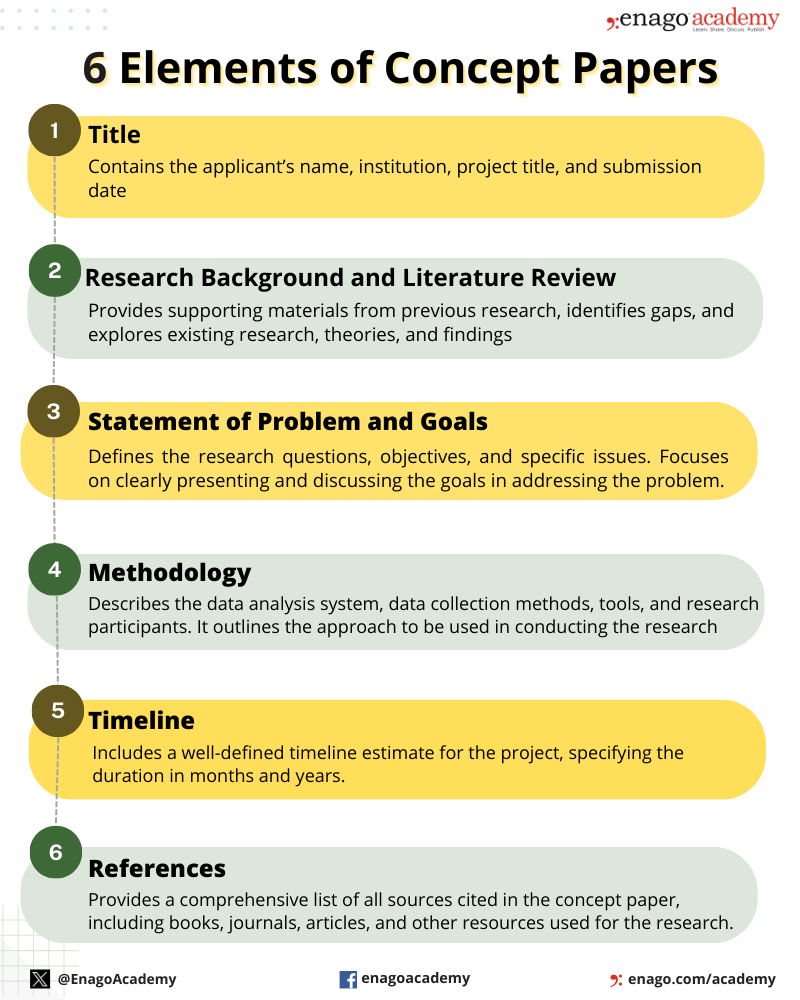
How to Write a Concept Paper?
To ensure an effective concept paper, it’s recommended to select a compelling research topic, pose numerous research questions and incorporate data and numbers to support the project’s rationale. The document must be concise (around five pages) after tailoring the content and following the formatting requirements. Additionally, infographics and scientific illustrations can enhance the document’s impact and engagement with the audience. The steps to write a concept paper are as follows:
1. Write a Crisp Title:
Choose a clear, descriptive title that encapsulates the main idea. The title should express the paper’s content. It should serve as a preview for the reader.
2. Provide a Background Information:
Give a background information about the issue or topic. Define the key terminologies or concepts. Review existing literature to identify the gaps your concept paper aims to fill.
3. Outline Contents in the Introduction:
Introduce the concept paper with a brief overview of the problem or idea you’re addressing. Explain its significance. Identify the specific knowledge gaps your research aims to address and mention any contradictory theories related to your research question.
4. Define a Mission Statement:
The mission statement follows a clear problem statement that defines the problem or concept that need to be addressed. Write a concise mission statement that engages your research purpose and explains why gaining the reader’s approval will benefit your field.
5. Explain the Research Aim and Objectives:
Explain why your research is important and the specific questions you aim to answer through your research. State the specific goals and objectives your concept intends to achieve. Provide a detailed explanation of your concept. What is it, how does it work, and what makes it unique?
6. Detail the Methodology:
Discuss the research methods you plan to use, such as surveys, experiments, case studies, interviews, and observations. Mention any ethical concerns related to your research.
7. Outline Proposed Methods and Potential Impact:
Provide detailed information on how you will conduct your research, including any specialized equipment or collaborations. Discuss the expected results or impacts of implementing the concept. Highlight the potential benefits, whether social, economic, or otherwise.
8. Mention the Feasibility
Discuss the resources necessary for the concept’s execution. Mention the expected duration of the research and specific milestones. Outline a proposed timeline for implementing the concept.
9. Include a Support Section:
Include a section that breaks down the project’s budget, explaining the overall cost and individual expenses to demonstrate how the allocated funds will be used.
10. Provide a Conclusion:
Summarize the key points and restate the importance of the concept. If necessary, include a call to action or next steps.
Although the structure and elements of a concept paper may vary depending on the specific requirements, you can tailor your document based on the guidelines or instructions you’ve been given.
Here are some tips to write a concept paper:
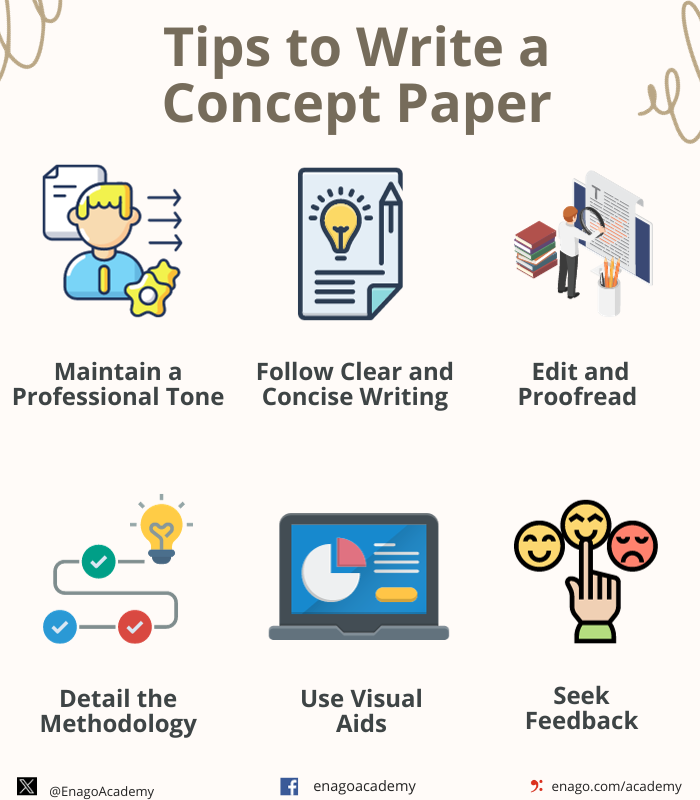
Example of a Concept Paper
Here is an example of a concept paper. Please note, this is a generalized example. Your concept paper should align with the specific requirements, guidelines, and objectives you aim to achieve in your proposal. Tailor it accordingly to the needs and context of the initiative you are proposing.
Download Now!
Importance of a Concept Paper
Concept papers serve various fields, influencing the direction and potential of research in science, social sciences, technology, and more. They contribute to the formulation of groundbreaking studies and novel ideas that can impact societal, economic, and academic spheres.
A concept paper serves several crucial purposes in various fields:
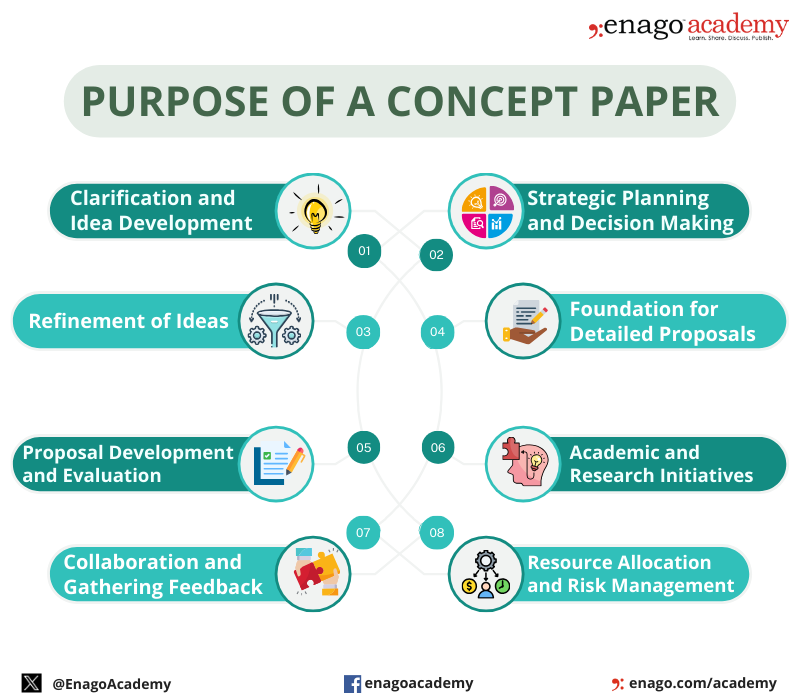
In summary, a well-crafted concept paper is essential in outlining a clear, concise, and structured framework for new ideas or proposals. It helps in assessing the feasibility, viability, and potential impact of the concept before investing significant resources into its implementation.
How well do you understand concept papers? Test your understanding now!
Fill the Details to Check Your Score

Role of AI in Writing Concept Papers
The increasing use of AI, particularly generative models, has facilitated the writing process for concept papers. Responsible use involves leveraging AI to assist in ideation, organization, and language refinement while ensuring that the originality and ethical standards of research are maintained.
AI plays a significant role in aiding the creation and development of concept papers in several ways:
1. Idea Generation and Organization
AI tools can assist in brainstorming initial ideas for concept papers based on key concepts. They can help in organizing information, creating outlines, and structuring the content effectively.
2. Summarizing Research and Data Analysis
AI-powered tools can assist in conducting comprehensive literature reviews, helping writers to gather and synthesize relevant information. AI algorithms can process and analyze vast amounts of data, providing insights and statistics to support the concept presented in the paper.
3. Language and Style Enhancement
AI grammar checker tools can help writers by offering grammar, style, and tone suggestions, ensuring professionalism. It can also facilitate translation, in case a global collaboration.
4. Collaboration and Feedback
AI platforms offer collaborative features that enable multiple authors to work simultaneously on a concept paper, allowing for real-time contributions and edits.
5. Customization and Personalization
AI algorithms can provide personalized recommendations based on the specific requirements or context of the concept paper. They can assist in tailoring the concept paper according to the target audience or specific guidelines.
6. Automation and Efficiency
AI can automate certain tasks, such as citation formatting, bibliography creation, or reference checking, saving time for the writer.
7. Analytics and Prediction
AI models can predict potential outcomes or impacts based on the information provided, helping writers anticipate the possible consequences of the proposed concept.
8. Real-Time Assistance
AI-driven chat-bots can provide real-time support and answers to specific questions related to the concept paper writing process.
AI’s role in writing concept papers significantly streamlines the writing process, enhances the quality of the content, and provides valuable assistance in various stages of development, contributing to the overall effectiveness of the final document.
Concept papers serve as the stepping stone in the research journey, aiding in the crystallization of ideas and the formulation of robust research proposals. It the cornerstone for translating ideas into impactful realities. Their significance spans diverse domains, from academia to business, enabling stakeholders to evaluate, invest, and realize the potential of groundbreaking concepts.
Frequently Asked Questions
A concept paper can be defined as a concise document outlining the fundamental aspects of a grant proposal such as the initial ideas, objectives, and theoretical framework of a proposed research project.
A good concept paper should offer a clear and comprehensive overview of the proposed research. It should demonstrate a strong understanding of the subject matter and outline a structured plan for its execution.
Concept paper is important to develop and clarify ideas, develop and evaluate proposal, inviting collaboration and collecting feedback, presenting proposals for academic and research initiatives and allocating resources.
I got wonderful idea
It helps a lot for my concept paper.
Rate this article Cancel Reply
Your email address will not be published.

Enago Academy's Most Popular Articles

- Reporting Research
Academic Essay Writing Made Simple: 4 types and tips
The pen is mightier than the sword, they say, and nowhere is this more evident…
![restaurant concept paper What is Academic Integrity and How to Uphold it [FREE CHECKLIST]](https://www.enago.com/academy/wp-content/uploads/2024/05/FeatureImages-59-210x136.png)
Ensuring Academic Integrity and Transparency in Academic Research: A comprehensive checklist for researchers
Academic integrity is the foundation upon which the credibility and value of scientific findings are…

- AI in Academia
AI vs. AI: How to detect image manipulation and avoid academic misconduct
The scientific community is facing a new frontier of controversy as artificial intelligence (AI) is…

- Diversity and Inclusion
Need for Diversifying Academic Curricula: Embracing missing voices and marginalized perspectives
In classrooms worldwide, a single narrative often dominates, leaving many students feeling lost. These stories,…

- Career Corner
- Trending Now
Recognizing the signs: A guide to overcoming academic burnout
As the sun set over the campus, casting long shadows through the library windows, Alex…

Sign-up to read more
Subscribe for free to get unrestricted access to all our resources on research writing and academic publishing including:
- 2000+ blog articles
- 50+ Webinars
- 10+ Expert podcasts
- 50+ Infographics
- 10+ Checklists
- Research Guides
We hate spam too. We promise to protect your privacy and never spam you.
I am looking for Editing/ Proofreading services for my manuscript Tentative date of next journal submission:

As a researcher, what do you consider most when choosing an image manipulation detector?
- Free Essays
- Citation Generator
"Restaurant concept paper sample" Essays and Research Papers
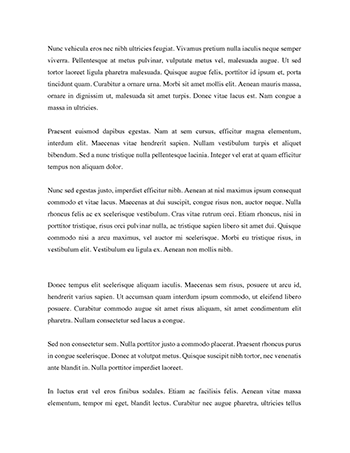
Restaurant Concept
My favorite restaurant concept is to create a restaurant /cafe that is friendly to the environment. The main focus of the restaurant will be to provide foods such as coffee‚ tea‚ pastries‚ sandwitches and at the same time focus on environment conservation. This concept resonates with my personality which is to keep my surrounding environment friendly and sustainable for future generation. Nature is very friendly and one of my dreams is to become friendly to it. The only way to appreciate nature is
Premium Natural environment Biodiversity Sustainability

Developing Concept of the Restaurant
Star Restaurant www.starrestaurant.com Table of Content Introduction. 3 Developing a Concept 3 Feasibility study 4 Location: 4 Market: 4 Competition: 4 Trends of locality: 5 Business Plan 7 Restaurant concept description: 7 Market Study 7 Management team 8 Organizational Chart 9 Detailed cost of Restaurant 9 Source of finance 11 Operation strategy 11 Marketing strategy 11 Production plan 12 Service plan 12 Customer services 13 Types of menu 13 Business design and layout
Premium Soup Chicken
Sample Restaurant Review
This restaurant review will look at one of Ithaca’s more popular dinner spots‚ The Boatyard Grill. With its prime lakefront location on Taughannock Boulevard‚ this restaurant frequently receives solid ratings from review sources such as Tripadvisor and Urbanspoon. From reading these reviews‚ it can be seen that customers regularly mention the Boatyard Grill’s nautical themed décor‚ friendly service‚ good food and of course the beautiful setting of Cayuga lake. A first impression of the Boatyard
Free Restaurant Food Menu

Restaurant Concept Statement
Cowgirls Steakhouse will be fun‚ country style restaurant that serves southern comfort food. It will be located right in the heart of Austin‚ the capital of Texas. The goal of the restaurant is to make every guest experience a great and exciting one and to serve good quality food at an affordable price. It will be a great place for almost any occasion because we will accommodate big parties and provide excellent service while making the experience memorable. The atmosphere of Cowgirls Steakhouse
Premium Peanut
Executive Summary -Restaurant Concept
Restaurant Concept Paul Lauriello 5-4-11 . My concept is for “Jay’s” a NY style Pizza place in Bell Town an urban neighborhood in Downtown Seattle which is right next to the Pike Place Market. I would be located amidst a block that has four bars that are fairly rowdy in the evening. During the day and early evening though the common traffic are office workers‚ tourists and local residents. . I want the atmosphere to be like the pizza places I grew up with on the boardwalk on the
Premium Pizza Naples

Sample Concept Paper for Masters Degree
1.1 Background of the study A study conducted by Hattie (2002) revealed that thirty percent of the variance in performance of students could be accounted for by what the teacher knows‚ does and cares about. He identified influences on the learner in terms of magnitude and concluded that the teachers’ feedback has the greatest influence on academic performance as compared to other factors. Teachers‚ in the education world‚ are considered as significant other in the life of their students and so‚ whatever
Premium Sampling Education
Restaurant Grading Ordinance Sample
Ms. Thomas‚ The restaurant grading ordinance is in place so that customers will be able to eat a meal that is both great tasting and safe to enjoy as well. Having had my own restaurant inspected by the county‚ I knew that passing the grading ordinance of LA is no easy task considering all the rules and regulations. For these‚ reasons‚ Canoe must pass the grading ordinance along with having satisfying food to be successful. The staff is a huge piece of keeping the restaurant’s
Premium Food Restaurant Eating
Example Restaurant Concept/Marketing Plan
X Concept : A Mediterranean Restaurant Concept Prepared for Professor of Restaurant Management HMT 410 DeVry University – Online Prepared by Student: Prepared on xx xx xxxx TABLE OF CONTENTS Introduction Concept Development Site Selection Market Analysis Competition Analysis Financial Analysis License & Approvals Design‚ Furnishings & Equipment Menu Development Employment of Key Personnel Selection & Training of Key
Premium Restaurant Olive oil Middle Eastern cuisine
Sample Paper
in Systems Analysis Page 1 of 4 SA Semester 2 Examination 2013/2014 Sample Paper 1 : Object Oriented Analysis and Design Appendix B Matriculation Number : (fill in your matriculation number here) SA Semester 2 Examination 2013/2014 ( Sample Paper 1 – Appendix B) Graduate Diploma in Systems Analysis Page 2 of 4 This page is intentionally left blank. SA Semester 2 Examination 2013/2014 ( Sample Paper 1 – Appendix B) Graduate Diploma in Systems Analysis Page 3 of 4
Premium Graphical user interface Object-oriented programming Alert dialog box
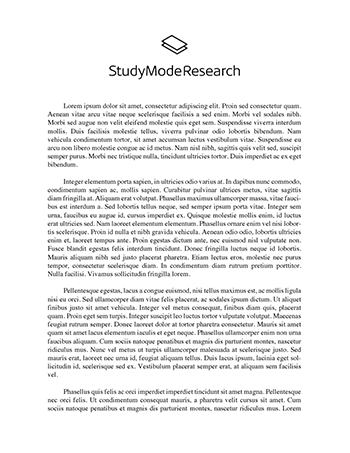
1 Formative Assesment – I- 2012 SAMPLE QUESTION PAPER CLASS Xth English - Communicative SECTION B (Writing- 20 marks) Q 5 Use the notes in the following box to write a paragraph of about 100 words. (4 Marks) Trip to Goa Wonderful place-open houses-eco-friendly People- friendly‚ happy-go-lucky Landscape-picturesque‚ beaches‚ clear blue water Restaurants - delicious sea food Sightseeing- ferry.bus‚ motorcycles available on rent Carnival- colourful‚ music ‚dance‚ fun and frolic Q 6. Your
- Agriculture
- Alert dialog box
- Biodiversity
- Customer service
- Display device
- Graphical user interface
- Restaurant conclusion
- Restaurant crisis management plan
- Restaurant customer satisfaction survey report
- Restaurant demographic factors
- Restaurant due diligence
- Restaurant end universe
- Restaurant ethical and corporate social responsibility policy
- Restaurant ethnography
- Restaurant evaluation
- Restaurant expansion business plan
Cafe Antresole

CAFE ANTRESOLE, Elektrostal - Restaurant Reviews, Photos & Phone Number - Tripadvisor

IMAGES
VIDEO
COMMENTS
The restaurant concept supported by restaurant branding will help you create a well-established business that is easily recognizable. Read more: 12 Restaurant Branding Ideas to Build a Memorable Presence. Benefits of Restaurant Concept Development. The good news is that you don't have to invest money in restaurant concept development.
14 Restaurant Concepts & Ideas. From casual restaurants and coffee shops to fast food chains and new trending restaurant concepts like the ghost kitchen, there's a restaurant concept for every owner and every diner. 1. Virtual Restaurants ClusterTruck is an Indianapolis-based virtual delivery kitchen. Diners can choose from an array of cuisines ...
Walk-Through. Step 1 | Pre-design. Much of the homework you do to write your restaurant business plan comes into play during this phase of the design process, says Steve Starr, president, starrdesign, Charlotte, N.C. "In this phase, you and the team you choose need to clearly understand your objectives and your budget model," he says.
A Step-by-step Guide to Creating a Restaurant Concept. Published by Karen Dinkin on August 7, 2023. Successful restaurants do more than just sell food. They sell an experience, and this is closely tied to the restaurant concept. A restaurant concept is the overarching theme of the restaurant that covers its ambiance and decor, location, menu ...
4 - Develop your menu. Your menu needs to keep with your overall concept, so if you are working backward, consider the type of food you are interested in creating. . If it's simple classic dishes, you'll likely have a traditional concept versus something scientific, modern, and edgy. Whatever you choose, run with it.
Financing your restaurant involves impressing pragmatic bankers or investors, and a well-written business plan includes concept details, market analysis and break-even projections. It also ...
A restaurant concept is the overall idea or theme that defines the restaurant. Concepts include your menu's design, service style, dining room decor, and — of course — the style of food. Many restaurants are conceived based on a chef's personal experiences or interests. Heritage, local ingredients, traditions, or family are all common ...
These 10 steps to learn how to conceptualize your restaurant or bar will guide you along the way. They range from mental plans and ideas to tangible steps you need to take. You'll also benefit from learning general tips on how to open a bar or restaurant. 10. Find Your Inspiration.
The weight, size, paper, presentation, fonts and typographies, photos, use of language and more are all important considerations in your restaurant menu. The menu should be viewed as an extension of the restaurant design - fully integrated in the brand personality and positioning. ... A restaurant concept with 20 beers on tap will have ...
Once you've developed your restaurant concept, it's time to start promoting it to attract customers. You can promote your restaurant through advertising, social media, word-of-mouth, and other marketing channels. The key is to get the word out about your restaurant so that potential customers are aware of it and will want to check it out.
A restaurant's concept is the lifeline of its brand and longevity in the market. It makes your venue stand apart from the competition, and it's ultimately your restaurant's unique selling proposition. A concept plan is something every aspiring restaurateur should look to complete. Due to the high level of risk for independent restaurant ...
However, having a successful food truck business requires a lot of effort, especially during an initial couple of years. 8. Pop Up Restaurant. A pop-up restaurant is another trending concept in the hospitality industry. With a history dating back to the 1960s, pop-up restaurants are not a new concept.
Start your concept statement by describing what kind of food you've chosen to make, and how the trappings of your restaurant will reflect the emphasis you've chosen. The more clearly you are able ...
So, now I will give you a simple guide on how to create a successful restaurant concept using the ideas that I have mentioned above. 1. Study your motivation and goals. Although you should put your customers' needs first at all times, it's a good idea to review the motivation behind your business.
Unique Restaurant Concept Creation Guide. Feb 19, 2020. McdonaldPaper. Winning concept is vital for a new restaurant's marketing. There are millions of food serving establishments in the United States, and your restaurant or bar concept may already exist somewhere. New concepts are hard to formulate, but it's possible with the right approach.
A restaurant concept is defined in this paper as the combination of all details in a restaurant operation that lead to a certain image with its customers. Although many elements impact the image, the image is mainly determined by the combination of attributes of food,
This conceptual paper gives a discussion of the studies conducted in the field. The review started with the setting of the Philippine food service industry and highlighted the booming theme ...
Additionally, infographics and scientific illustrations can enhance the document's impact and engagement with the audience. The steps to write a concept paper are as follows: 1. Write a Crisp Title: Choose a clear, descriptive title that encapsulates the main idea. The title should express the paper's content.
Executive Summary -Restaurant Concept. Restaurant Concept Paul Lauriello 5-4-11 . My concept is for "Jay's" a NY style Pizza place in Bell Town an urban neighborhood in Downtown Seattle which is right next to the Pike Place Market. I would be located amidst a block that has four bars that are fairly rowdy in the evening.
Ermitazh, Elektrostal: See 25 unbiased reviews of Ermitazh, rated 4.0 of 5 on Tripadvisor and ranked #5 of 30 restaurants in Elektrostal.
Top Restaurants in Elektrostal. We found great results, but some are outside Elektrostal. Showing results in neighboring cities. Limit search to Elektrostal. 1. Restaurant Khalif. One of amazing restaurant ever , you need to visit guys, من اجمل المطاعم الذي... The impressions are positive. The food is very tasty.
Restaurant Globus. 67. 0.58 miles away. Dodo Pizza. 4. 0.67 miles away. Best nearby attractions. See all. SmokyGrove. 1. 0 miles away. Statue of Lenin. 16. 0 miles away. Park of Culture and Leisure. 16. 0 miles away. Viki Cinema. 8. 0 miles away. Is This Your Listing? Own or manage this property? Claim your listing for free to respond to ...
The concept of the show is simple! On a massive world map, 61 AI Civilizations see which one can be the last one standing. All Civilizations were chosen by the audience of /r/civbattleroyale and part of the fun is helping narrate the story collectively along with original content and putting your support behind one of the competitors.